#years active as a singer 1960-present
Text
August 31, 1961: Bob Wooler predicts the Beatles’ future in Mersey Beat
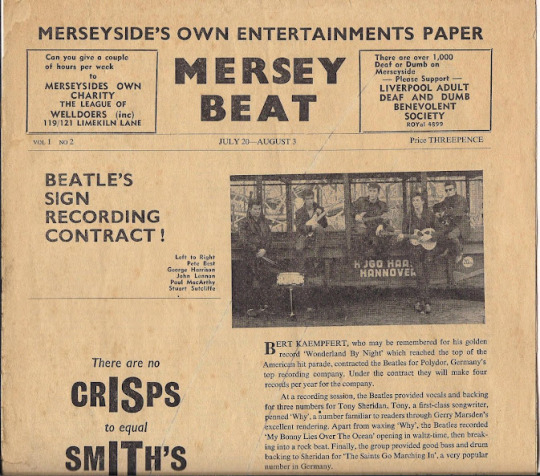
A PHENOMENON CALLED THE BEATLES!
by Bob Wooler [x]
Why do you think The Beatles are so popular? Many people many times have asked me this question since that fantastic night (Tuesday, December 27th, 1960) at Litherland Town Hall, when the impact of the act was first felt on this side of the River. I consider myself privileged to have been associated with the launching of the group on that exciting occasion, and grateful for the opportunities of presenting them to fever-pitch audiences at practically all of the group’s subsequent appearances prior to their last Hamburg trip.
Perhaps my close association with the group’s activities, both earlier this year and since their recent reappearance on the Merseyside scene, persuades people to think that I can produce a blueprint of The Beatles Success Story. It figures, I suppose, and if, in attempting to explain the popularity of their act, the following analysis is at variance with other people’s views, well that’s just one of those things. The question is nevertheless thought-provoking.
Well then, how to answer it? First some obvious observations. The Beatles are the biggest thing to have hit the Liverpool rock ’n’ roll setup in years. They were, and still are, the hottest local property any Rock promoter is likely to encounter. To many of these gentlemen’s ears, Beatle-brand noises are cacophonous on stage, but who can ignore the fact that the same sounds translate into the sweetest music this side of heaven at the box office!
I think The Beatles are No. 1 because they resurrected original style rock ’n’ roll music, the origins of which are to be found in American negro singers. They hit the scene when it had been emasculated by figures like Cliff Richard and sounds like those electronic wonders The Shadows and their many imitators. Gone was the drive that inflamed the emotions. This was studio set jungle music purveyed skillfully in a chartwise direction by arrangement with the A & R men.
The Beatles, therefore, exploded on a jaded scene. And to those people on the verge of quitting teendom—those who had experienced during their most impressionable years the impact of rhythm ’n’ blues music (raw rock ’n’ roll)—this was an experience, a process of regaining and reliving a style of sounds and associated feelings identifiable with their era.
Here again, in The Beatles, was the stuff that screams are made of. Here was the excitement—both physical and aural—that symbolized the rebellion of youth in the ennuied mid-1950’s. This was the real thing. Here they were, first five and then four human dynamos generating a beat which was irresistible. Turning back the Rock clock. Pounding out items from Chuck Berry, Little Richard, Carl Perkins, The Coasters and the other great etceteras of the era. Here they were, unmindful of uniformity of dress. Unkempt-like long hair. Rugged yet romantic, appealing to both sexes. With calculated naivete and an ingenious, throw-away approach to their music. Affecting indifference to audience response and yet always saying “Thank-you.” Reviving interest in and commanding enthusiasm for numbers which descended the Charts way back. Popularizing (more than any other group) flipside items—example, “Boys.” Compelling attention and influencing, wittingly or unwittingly, other groups in the style, choice and presentation of songs.
Essentially a vocal act, hardly ever instrumental (at least not in this country), here they were, independently minded, playing what they liked for kicks, kudos and cash. Privileged in having gained prestige and experience from a residency at the Hamburg Top Ten Club during the autumn and winter of last year. Musically authoritative and physically magnetic, example the mean, moody magnificence of drummer Pete Best—a sort of teenage Jeff Chandler. A remarkable variety of talented voices which song-wise sound distinctive, but when speaking, possess the same naivete of tone. Rhythmic revolutionaries. An act which from beginning to end is a succession of climaxes. A personality cult. Seemingly unambitious, yet fluctuating between the self-assured and the vulnerable. Truly a phenomenon—and also a predicament to promoters! Such are the fantastic Beatles. I don’t think anything like them will happen again.
———
Retrospective from Bill Harry, Editor of Mersey Beat [x]
Editor’s note: Cavern disc jockey Bob Wooler, a Mersey Beat columnist, penned this piece in the August 31 1961 issue of Mersey Beat. How prophetic his last sentence proved to be! In recent years I told Bob I intended to revive Mersey Beat and I wanted him back in the fold as a columnist. Sadly, he died early in 2002 while I was still panning the website.
There are one or two things I would like to point out. The main advertisement on this page was for NEMS record store. Apart from the fact that I regularly discussed the Beatles and the Mersey scene with Brian Epstein each time I dropped copies to him, in addition to the fact that he began to review records for me from Issue No. 3, it is obvious from the sort of coverage, such as this article, which the Beatles were receiving every issue, that Epstein was aware of the Beatles from Mersey Beat and not some youngsters asking for a record in his store some months later. Bob also mentions the impact the group made at Litherland Town Hall. It was Bob who persuaded promoter Brian Kelly to book them for their debut appearance there on that date. It's also interesting to note that the only member of the Beatles mentioned by name is drummer Pete Best. Bob nicked the 'mean, moody, magnificent' tag from Howard Hughes' description of Jane Russell in the movie 'The Outlaw.' As this article was published in 1961, Bob did get something wrong: he mentions a residency at the "Hamburg Top Ten Club during the autumn and winter of last year." They only had residencies at the Indra and Kaiserkeller in 1960, although they made a few appearances at the Top Ten (Their Top Ten residency didn't actually commence until 1961).
#the beatles#bob wooler#1961#mersey beat#august 1961#newspaper clippings#beatles and the press#the humble beginnings#as transcribed in tune in#havent seen this one anywhere on here#been looking for the clipping but havent found it#if youve seen it give a shout#oh found the copy on the mersey beat archives#have to get bill harrys note bc its a great example of how a good story works#not a clipping tho so an august beatles cover is the closest i can get#litherland#december 1961#hamburg era#brian epstein#bill harry#ran into crit bill harry got from other liverpool bands during the early merseybeat days bc he would write so much about the beatles#so its impossible the beatles had missed brians radar before the my bonnie record request#‘beatles sign recording contract’ aww they mean the german label printed my bonnie how cute
25 notes
·
View notes
Text
THIS DAY IN GAY HISTORY
based on: The White Crane Institute's 'Gay Wisdom', Gay Birthdays, Gay For Today, Famous GLBT, glbt-Gay Encylopedia, Today in Gay History, Wikipedia, and more …

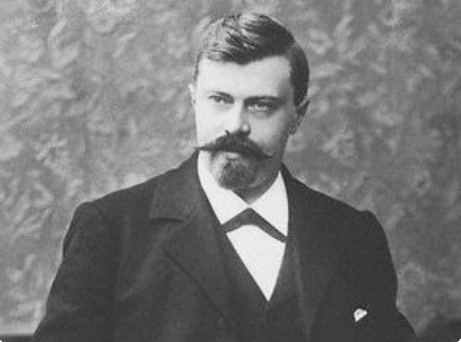
1867 – Wassily Sapellnikoff (d.1941), was a Russian pianist. A more true transliteration of his name is Vasily Lvovich Sapelnikov, however he chose the above version for his appearances in the West.
Sapellnikoff was born in Odessa. He studied at the Odessa Conservatory and became professor of piano at Moscow Conservatory in 1897. He eventually moved to Leipzig and finally settled in Munich.
He toured with Tchaikovsky in Germany, France and England. At his debut in Hamburg in 1888, he played Tchaikovsky's Piano Concerto No. 1 in B flat minor with the composer conducting. This concert was a great success and a catalyst for his budding career as a concert pianist in Western Europe. He was the first to play this concerto in England. He was the dedicatee of a piano piece by Tchaikovsky.
Tchaikovsky wrote about him affectionately in his letters to his brother Modest, in terms such as: Since the time of Kotek I have never loved anyone so warmly as him. Because they spent so much time together on these tours, it is often asserted that he and Tchaikovsky were lovers. However, Alexander Poznansky, in Tchaikovsky: The Quest for the Inner Man, writes:
it seems likely that an erotic element was present in Tchaikovsky's friendship with Sapelnikov and that he recognised it as such. Both men were quite young and good-looking. Almost certainly, however, their relations remained chaste.
Sapellnikoff first appeared in England in 1889 playing the Tchaikovsky concerto at a Royal Philharmonic concert, under the composer's baton. He became a favourite at Philharmonic concerts.


1906 – Luchino Visconti di Modrone, Count of Lonate Pozzolo (d.1976) was an Italian theatre, opera and cinema director, as well as a screenwriter. He is notably known for his films The Leopard (1963) and Death in Venice (1971).
When he was thirty years old, he began his career in film, working as an assistant director and costume designer for French director Jean Renoir, whom he knew socially. As a result of his association with Renoir, Visconti became a leftist in politics. Although he had close connections with Mussolini's son Vittorio, he became active in the anti-fascist movement and, during World War II, in the Resistance.
Also in his early thirties, he had his first serious homosexual affair, with a young German photographer named Horst, who became a well known fashion photographer. The affair lasted three years, but their friendship endured until Visconti's death.
His first feature film, Ossessione (1942), with its insistence on location shooting, proletariat subject matter, and an unvarnished approach to reality, is acknowledged as the first manifestation of Neo-Realism. However, Visconti's film, Bellissima (1951), with a brilliant star performance by Anna Magnani, is a satire of Neo-Realism, as a working-class mother tries to get her little girl cast in a Neo-Realist film.
Early in his career he maintained a scrupulous detachment from the actors and singers whose careers he helped to launch; but by the end of the 1960s, he became passionately involved with several young artists. This aspect of his life came to light when letters that he wrote to several young men, including Helmut Berger, became public in the 1980s.
Visconti made no secret, to those close to him, of his homosexuality. His last partner was the Austrian actor Helmut Berger, who played Martin in Visconti's film The Damned. Berger also appeared in Visconti's Ludwig in 1972 and Conversation Piece in 1974 along with Burt Lancaster. Other lovers included Franco Zeffirelli, who also worked as part of the crew (i.e. production design, assistant director, etc.) in a number of Visconti's films and theatrical productions.
He died in Rome of a stroke at age 69.


1916 – John Burnside, inventor and Gay American activist was born (d: 2008). John was the inventor of the Teleidoscope and the Symmetricon, and was the partner of Mattachine and Radical Faerie founder, Harry Hay for 39 years.
Burnside was sent to an orphanage while still a child because he was caught in sexual play with another little boy. He served briefly in the Navy, and settled in Los Angeles in the 1940s. He married, but had no children.
Burnside met Harry in 1962 at ONE Incorporated. They fell in love and became life partners. They formed a group in the early 1960s called the Circle of Loving Companions that promoted Gay rights and Gay love. In 1966 they were major planners of one of the first Gay parades, a protest against exclusion of Gays in the military, held in Los Angeles. In 1967, they appeared as a couple on the Joe Pyne television show. In the late 1970s, they were instrumental in founding the Radical Faeries.
John died of brain cancer in San Francisco, where he had been tended to by members of the Circle of Loving Companions that had taken care of Harry in his final days.


1943 – Casey Donovan (d.1987) was an American male pornographic actor of the 1970s and 1980s, appearing primarily in adult films and videos catering to gay male audiences.
Following a brief career as a teacher and a stint as a highly-paid male model, Donovan appeared in the film that would cement his status as a gay icon, Boys in the Sand, in 1971. Attempts to build on his notoriety to achieve mainstream crossover success failed, but Donovan continued to be a bankable star in the adult industry for the next 15 years.
Casey Donovan was born John Calvin Culver in East Bloomfield, New York. He graduated from teachers' college in 1965 and after graduation he drifted into being a prostitute and relocated to New York City. He also began pursuing an acting career, appearing in summer stock theatre with the prestigious Peterborough Players.
In 1971, Culver played a supporting role in a low budget sexploitation thriller film, Ginger. This in turn led to an offer to appear in Casey, a gay pornographic film in which Culver played the title role, a gay man who is visited by his fairy godmother Wanda (Culver playing a dual role in drag), and is granted a series of wishes which make him sexually irresistible to other men. Culver later took the character's name, Casey, and that of the popular singer Donovan to create the pseudonym under which he would appear in all his other erotic roles.

Culver first appeared as Casey Donovan in Boys in the Sand, in 1971. The film was an instant success and is considered one of the great classics of male erotic cinema. With the success and celebrity he garnered from the film, Donovan believed that he would be able to cross over into mainstream film. While there were meetings with directors like John Schlesinger and Raymond St. Jacques and talk of casting him in mainstream projects including adaptations of novels by Mary Renault and Patricia Nell Warren, the only film opportunities opened for him were as the star of more erotic films.
Donovan had a successful national tour in the play Tubstrip, written and directed by Jerry Douglas. The play was critically deemed entertaining enough to its target gay audience (having earned, in the words of one critic, a "nationwide gay housekeeping seal of approval").
Donovan's iconic status allowed him to build a lucrative career as a high-priced prostitute although it would cost him his legitimate modeling career as more and more clients made the connection between model Culver and porn star Donovan. He wrote an advice column,"Ask Casey," for the gay-oriented Stallion magazine beginning in 1982.
In 1973 at the height of his popularity, Donovan met actor-turned writer Tom Tryon and the two entered into a long-term relationship the following year. Tryon was deeply closeted and grew increasingly disturbed by Donovan's notoriety. Their relationship ended in 1977.
By 1985, Donovan's health had begun to deteriorate, as he had contracted HIV. Although he had counseled his fans through his "Ask Casey" column as early as 1982 to reduce their number of sex partners and take steps to preserve their health and urged them to be tested for HIV once the test was developed, he himself made little or no effort to change his behavior. Donovan died in 1987 of an AIDS-related pulmonary infection in Inverness, Florida, aged 43.


1944 Patrice Chéreau (d.2013) was a French opera and theatre director, filmmaker, actor and producer. In France he is best known for his work for the theatre, internationally for his films La Reine Margot and Intimacy, and for his staging of the Jahrhundertring, the centenary Ring Cycle at the Bayreuth Festival in 1976. Winner of almost twenty movie awards, including the Cannes Jury Prize and the Golden Berlin Bear, Chéreau served as president of the jury at the 2003 Cannes festival.
From 1966, he was artistic director of the Public-Theatre in the Parisian suburb of Sartrouville, where in his team were stage designer Richard Peduzzi, costume designer Jacques Schmidt and lighting designer André Diot, with whom he collaborated in many later productions. From 1982, he was director of "his own stage" at the Théâtre Nanterre-Amandiers at Nanterre where he staged plays by Jean Racine, Marivaux and Shakespeare as well as works by Jean Genet, Heiner Müller and Bernard-Marie Koltès.
He accepted selected opera productions, such as: the first performance of the three-act version of Alban Berg's Lulu, completed by Friedrich Cerha, at the Paris Opera in 1979; Berg's Wozzeck at the Staatsoper Berlin in 1994; Wagner's Tristan und Isolde at La Scala in 2007; Janáček's From the House of the Dead, shown at several festivals and the Metropolitan Opera; and, as his last staging, Elektra by Richard Strauss, first performed at the Aix-en-Provence Festival in July 2013. He was awarded the Europe Theatre Prize in 2008.
Chéreau was in a long-term relationship with his lover and favorite actor Pascal Greggory. He was not interested in gay topics, saying: "I never wanted to specialise in gay stories, and gay newspapers have criticised me for that. Everywhere love stories are exactly the same. The game of desire, and how you live with desire, are the same."
Chéreau died in Paris on 7 October 2013 from lung cancer. He was 68 years old.

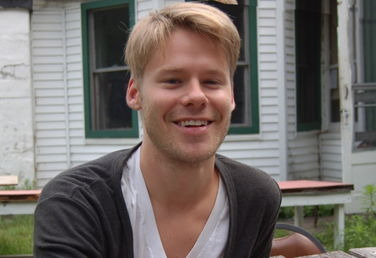
1977 - Today is the birthday of American actor Randy Harrison, Justin of Queer As Folk (US) . Harrison was born in Nashua, New Hampshire, but moved to Alpharetta, Georgia with his family at the age of eleven. He attended Pace Academy, a private prep school in Atlanta. His father is an executive with a large paper company, while he has described his mother as a "thwarted artist."
Randy, who is openly gay, has said: "I love my parents. Coming out to them was sort of coming out to myself. I educated them, and I wanted our relationship to keep growing. I wanted them to be a part of my life still. I wanted to be able to share with them what I was going through."
Harrison attended the University of Cincinnati's College-Conservatory of Music, where he ultimately received his Bachelor of Fine Arts degree in musical theatre. During his time at CCM, he starred in university productions such as Hello Again, Shopping and Fucking, and Children of Eden. He also had other roles in other theatrical venues across the United States at the time.
Randy made his television debut playing Justin Taylor, a gay teen, in 2000's American version of Queer as Folk, based upon the British television series. Known for his optimism and cheery disposition, Justin was a gay teen who sought out a gay community in his hometown of Pittsburg. After losing his virginity to Brian Kinney (played by Gale Harold) during his senior year of high school, Justin falls in love with Brian, and their relationship becomes a central part of the series. "When you watch it, you're like, Wow. I look like that. But it doesn't feel like that at all. It was about communicating with Gale Harold and getting across what I wanted to say about the character," he said. The series ran for five seasons, ending in 2005. In 2007, the character of Justin Taylor was voted number three on the list of top 25 gay television characters of all time by AfterElton.
In 2002, Randy starred in the play Deviant at the New York International Fringe Festival. In the summer of 2004, Harrison made his broadway debut as Boq in the musical Wicked. His Off Broadway credits include A Letter from Ethel Kennedy (2002), Oak Tree (2006), Antony and Cleopatra (2008), Edward II (2007-2008) and The Singing Forest (2009). He also has a substantial resume in regional theatre, most prominently as a featured player since 2005 at the Berkshire Theatre Festival. Roles with the BTF include Equus (2005), Amadeus (2006), One Flew Over the Cuckoo's Nest (2007), Mrs Warren's Profession (2007), Waiting for Godot (2008), Ghosts (2009) and Endgame (2010).
"It makes me proud, and it makes me scared," he said of acting. "More than anything, I want to be an actor and I want to keep working, and I think there's a danger in being perceived as a poster boy for something."
In 2006, Randy co-founded the Arts Bureau (tAB), an umbrella organisation encompassing theatre, film, music and writing. He shot and starred in the first tAB short film, Thinking, in 2008, which has since shown at several film festivals.
Randy dated Advertising Age columnist Simon Dumenco from 2002 to 2008; the two met when Dumenco interviewed Randy for a New York magazine cover story. Now single, he resides in Williamsburg,
Brooklyn with his cats Ella and Aggie.

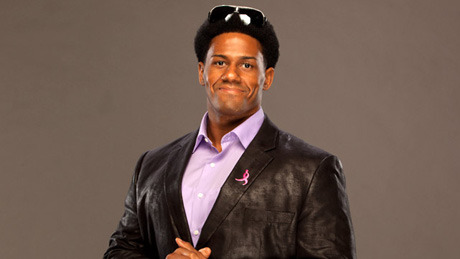
1983 – Fred Rosser who goes by the ring name of Darren Young is an American professional wrestler, currently signed to WWE . Prior to signing with WWE, Rosser competed in Northeastern and Mid-Atlantic independent promotions including Chaotic Wrestling, East Coast Wrestling Association, Independent Wrestling Federation and the National Wrestling Alliance. He is also the first WWE performer to disclose that he is gay while still active with the company.
Rosser/Young was born in Union, New Jersey. He began watching professional wrestling during the mid-1980s and became interested in becoming a professional wrestler as a teenager, wrestling in several backyard wrestling federations. He attended Fairleigh Dickinson University where he played football for a year, before deciding to focus on his academic studies and professional wrestling.
Rosser became interested in becoming a professional wrestler as a teenager, wrestling in several backyard wrestling federations. He researched a number of wrestling schools before deciding on Camp IWF in West Paterson, New Jersey. This was due in part to his employer, whose uncle was a friend of a local wrestler training there at the time, and helped him enroll in the wrestling school.
In an interview released on August 15, 2013, he publicly discussed being gay, making him the first wrestler ever to come out while still signed to a major promotion. Later that day, WWE released a statement in support of Rosser for being open about his sexuality, and various fellow wrestlers tweeted their support for him. He also revealed that he had a stuttering problem throughout childhood.


9 notes
·
View notes
Text
Soprano Pauline Donalda Speaks About Her Recordings (1960s?)
Pauline Donalda (1882–1970), Canadian soprano, and tireless promoter of Canadian opera, teacher, administrator. Donalda was born Pauline Lightstone in Montreal into a Jewishly active East European immigrant home. As a child she attracted attention for the quality of her voice and studied music on scholarship at the Royal Victoria College. In 1902 she went to Paris on a grant from Donald Smith (Lord Strathcona), after whom she adopted the professional surname of Donalda. She made her London debut at Covent Garden in 1905 singing Micaela under the direction of Andre Messager, her Canadian debut in 1906 singing with her husband (Paul Seveilhac) in the Montreal Arena, and her New York debut later that same year in Faust. In the spring of 1910 Donalda opened the Covent Garden season and returned in 1912 singing in both Les Huguenots and I Pagliacci, again with her husband. She was about to leave Canada for a European tour when World War i broke out. She remained in Canada, often giving benefit concerts in support of the war effort. In 1917 she returned to Paris, where she sang in Balfe's Le Talisman, sharing the stage with her new husband, Mischa Leon (b. Haurowitz).
Pauline Donalda's parents were Jews from Poland and Russia who immigrated to Montreal, changing the family name from Lichtenstein to Lightstone. The quality of Pauline's voice attracted attention, and she was awarded a music scholarship at the Royal Victoria College. When Sir Donald Smith, Lord Strathcona, gave Pauline a grant to study in Europe, she adopted the name "Donalda" in his honor. After her London debut in 1905, she sang frequently, often when Nellie Melba required a replacement (in this way, Donalda sang Mimi with Caruso). She married the French baritone, Paul Seveilhac, a cast member in the 1905 production of Faust in which Donalda sang Marguerite. She toured Russia, North America, and Europe. In February 1914, she had a huge success in Carmen in Nice.
During World War I, Donalda stayed in Canada where she organized the Donalda Sunday Afternoon Concerts. When the war ended, she returned to Paris where she married the Danish tenor Mischa Léon in 1918, after a divorce from her first husband. Subsequent to retiring from the stage, she opened a teaching studio in 1922 and taught hundreds of pupils. Donalda continued her teaching career in Montreal in 1937 and founded the Opera Guild (1942) over which she presided until 1969; the guild presented 29 operas during this time. Although her performing career was relatively short, Donalda had a great impact in the musical world as a teacher and promoter of opera. She was made an Officer of the Order of Canada in 1967 for her contributions to music.
In 1922 Donalda left the stage to devote her life to teaching, opening a studio in Paris. She returned to Montreal in 1937, where she opened a studio, and in 1942 founded the Opera Guild, the company she directed until 1969. During her relatively short performing career, Donalda was recognized for the purity of her voice and for her musicality, fine diction, and powerful stage presence. She is remembered for the unfailing energy with which she promoted opera in Montreal and encouraged talented young Canadian singers. Donalda also was very active in support of Jewish music in Montreal and the study of music at the Hebrew University of Jerusalem.
#classical music#opera#music history#bel canto#composer#classical composer#aria#classical studies#maestro#chest voice#Pauline Donalda#Donalda#classical musician#classical musicians#classical voice#classical history#classical art#musician#musicians#music education#music theory#history of music#historian of music#Metropolitan Opera#Conservatoire de Paris#Covent Garden#Royal Opera House#voice teacher
4 notes
·
View notes
Text
"CINEMATOGRAPHY"
by: JCeniza

The science and art of making motion pictures is known as cinematography. It involves methods like general scene composition, lighting of the set or location, selection of cameras, lenses, filters, and film stock, camera angle and movement, and integration of any special effects.

The director of photography, sometimes known as the cinematographer, first cameraman, lighting cameraman, or director of photography, is in charge of getting the director's desired photographic images and effects. All these issues may involve a large crew on a feature film.
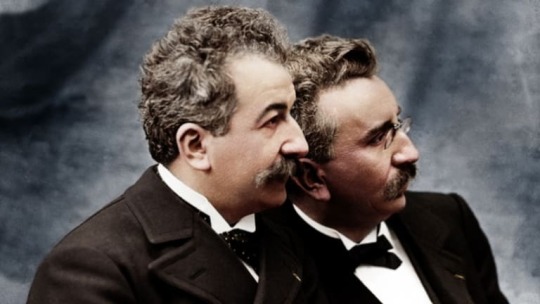
The Lumière Brothers invented the Cinèmatographe, which means "writing with light and motion" in Greek, in 1895, combining a camera and a projector, allowing Parisians to view projected films for the first time. Technicolor was invented in 1917, making it possible to exhibit films in color for the first time. Formerly, color had to be added after filming, which took time. Yet, color film did not become widely used until the 1970s. The Jazz Singer, the first sound movie, was released in 1927.

The introduction of sound in movies posed a problem for cinematographers. In order to hide their noises, cameras at the time had to be put in big boxes because they were loud. This made moving around challenging. Moving a camera swiftly was almost impossible before the "barney" was created. Cinematographers are no longer required to carry about heavy equipment in the present Hollywood period; instead, it is their technological expertise and proficiency with the camera that make them so vital to the business. Perhaps more than any other gadget, the motion picture camera can simultaneously be autonomously active and indefinitely passive (Deren 1960). Filmmaking would not be possible without cinematography. It is about using imaginative images to support a narrative and elicit a response from the audience. Modern filmmakers frequently neglect the reality that it is less about the tools you use and more about how you utilize them. Filmmaking would not be possible without cinematography. It is about using imaginative images to support a narrative and elicit a response from the audience. Modern filmmakers frequently neglect the reality that it is less about the tools you use and more about how you utilize them.
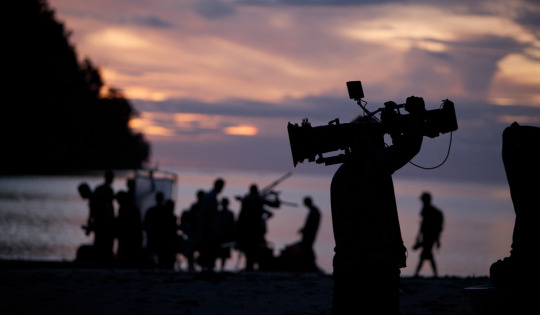
"In the digital age, everybody may buy and own their own camera," says Los Angeles-based cinematographer Alicia Robbins (The Wedding Invitation, Dawn of the Planet of the Apes). Producers and filmmakers are led to believe that their film will not qualify as a movie if they do not use the Arri Alexa to shoot it. When did filmmakers and producers stop looking for a cameraman who understood strong storytelling, lighting, and composition? "Cinematographers are just as good at telling stories as directors; the difference is that they work with images rather than performers.” We are not only generating beautiful pictures; we are telling emotional stories with the visuals. I believe that to be a major misconception. According to Rodrigo Prieto, during this year's awards season The Hollywood Reporter cinematographers’ roundtable, "People think it is good cinematography because it's beautiful.” Prieto was the cinematographer on The Wolf of Wall Street, 8 Mile, and Brokeback Mountain in addition to being nominated for an Oscar for his work on Martin Scorsese's Silence.
2 notes
·
View notes
Photo
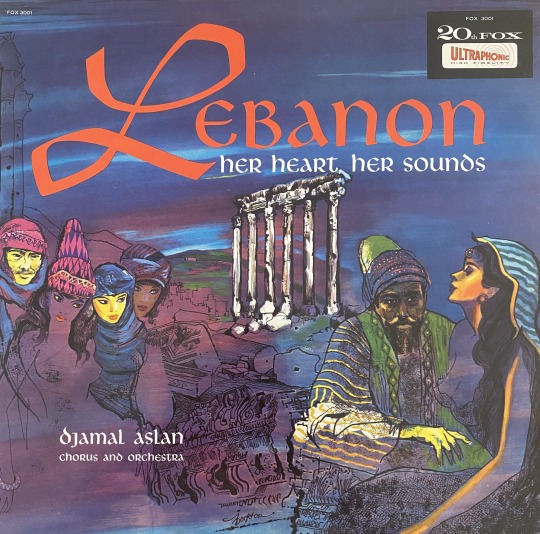

n September 1950, the 29-year-old Aleppo-born Assyrian singer Djamal A. Aslan flew into New York City from Gander, Newfoundland, Canada, representing himself as Iranian and having an address in Central Falls, Rhode Island. It is clear that he was not Iranian and unclear if he had been in the U.S. previously. In 1952, he married one Rose Arena in Brooklyn, and the couple divorced less than two years later in Florida. Whether he was actively trying to undermine U.S. immigration laws, we cannot say with any certainty, but it does look that way from this distance.
By November 1953, he had he begun performing. We know he appeared with the Damascus-born, Boston-based singer Russell Bunai and violinist Louis Badwi at the Syriac (Assyrian) Orthodox Church In West New York, New Jersey. And he was very active as a performer in 1954-55, playing with Naif Agby, Philip Solomon, Naim Karacand, Mike Hamway, Mohammed El-Bakkar, Eddie Kochak, Odette Kaddo, etc. Notably, he made a string of appearances during ’54-55 with the brilliant and celebrated Aleppo-born Egyptian violinist Sami al Shawwa (b. 1889; d. 1965) who was on tour in the U.S. at the time.
In 1955 he married Alberta Olever of Paterson NJ, and they settled on the same block of Brooklyn’s Atlantic Avenue as Albert Rashid’s and Fred Alam’s record stores. He could easily have recorded for either of their labels but did not. Instead, he played constantly at Arab-American gatherings in New York, New Jersey, and Pennsylvania (with a visit to California in 1957) and set up a music studio on Flatbush Avenue that he called Cinara-Phone where he started giving music lessons.
Between gigs, teaching, and the birth of his two daughters during 1957, he self-produced a group of 14 recordings with all of the best Arab performers in Brooklyn and sold them to the record subsidiary of the 20th Century Fox film company. They were released together as an in April 1958 as Lebanon: Her Heart, Her Sounds, an elaborate - one might say “overblown” for an immigrant - production including a 37-member choir, dozens of performers, and a cover painting by the popular illustrator Irv Doctor (b. 1918; 2008). It was certainly made under the influence of the singer and film star Farid al-Atrash. Its title reference to Lebanon was meant to attract the largest Arabic-speaking group the U.S. (It was also issued in Argentina.) It was clearly the culmination of his hopes and dreams as an American immigrant.
Did it accomplish its aims for Aslan? Not that we can detect. In 1959, he traveled as far as Connecticut and Florida to play gigs for Arab-American gatherings. In 1960, he got the news that his mother Zahida had died in Aleppo. It does not appear that he was able to travel to visit his father Aboud, his sister Antoinette Sayad, and his brother Antoine at the time. So, he stayed in Brooklyn, playing gigs at Arab-American social events and teaching, year after year.
In the mid-60s, the scene for live music at Arab-American events dwindled to almost nothing, and many players had made the transition to playing multi-ethnic nightclubs. Djamal Aslan however did not. He made no more records, and at present, we have no more documentation of his having performed after 1966. He died in Brooklyn June 11, 2000.
Several pieces from his LP appear on our recent Hakki Obadia collection.
5 notes
·
View notes
Text
Artiste of the day: Captain & Tennille
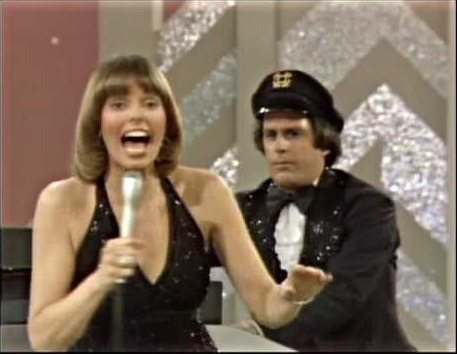
If there was a love story that gradually became a heartbreak in old age, it was that of Captain & Tennille, one of the biggest middle-of-the-road music acts ever. They were most active in the late 1970s and early 1980s.
Toni Tennille and her husband Daryl Dragon were one of the few musical acts of the time that were also a married couple (the only other examples of the period being the two couples in ABBA). They first began their careers in the 1960s performing as keyboardists and backup singers for Brian Wilson and his band. After famously donning a naval officer's cap during one concert, Daryl Dragon got his nickname "Captain" from Brian's brother Dennis. Tennille and Dragon married in 1975, the same year they released their breakthrough single, a cover of the Neil Sedaka song "Love will keep us together":
youtube
Tennille was the more vivacious, outspoken, and creative half of the couple. She loved performing and being an entertainer. For starters, she was a classically-trained keyboardist and mezzo-soprano singer. She hosted her own syndicated talkshow on television, The Toni Tennille Show, where she interviewed such guests as Ginger Rogers and Marie Osmond. And she also wrote and sang most of Captain & Tennille's original material, including the 1980 Billboard Hot 100 Number 1 smash, "Do that to me one more time":
Dragon, on the other hand, was a man of very few words, rarely saying anything apart from the occasional backup vocal when on television or performing live, preferring to let his wife do the talking. He did, however, speak more when encouraged to do so, such as in this interview on his wife's talkshow:
Before he met Tennille, Dragon had been in a band with his brothers; along with his brother Doug, he sang co-lead vocal on one of their singles, "Mercy call" (featuring Tennille on backing vocals). This seems to have been the only time ever where the Captain did a lead vocal.
youtube
After 39 years of marriage, Captain & Tennille divorced in 2014. Dragon died in 2019 at the age of 77.
Captain & Tennille were essentially one of the best examples of specialists in the middle-of-the-road style of music - so named because it does not fit anywhere, yet fits anywhere.
Middle-of-the-road music is usually keyboard- or piano-based. Most songs are slow ballads, though there are some that are upbeat, and some slow songs have a bit of electric guitars playing "power" chords; but all have a toned-down nature. The lyrics tend to focus on love-related themes, often anguish or angst-based issues. Some middle-of-the-road songs are instrumental. Many artistes coming from all genres and backgrounds have done middle-of-the-road music; some, like Captain & Tennille as above, were specialists in the style, meaning they did it exclusively. The style was biggest in the 1970s, 1980s, 1990s, and early 2000s, and the majority of middle-of-the-road music and artistes come from these periods.
Middle-of-the-road music has often been given wrong names, largely due to the competitive music marketing industry attempting to "classify" their artistes. Among other wrong monikers, it has been called things like "soft rock" - but it isn't because it doesn't have the rebellious nature of rock; "smooth jazz" (especially for instrumentals) - but it lacks the improvisational nature of jazz; or even "lite pop" - but the artistes don't possess the glamor of such pop artistes as Michael Jackson or Madonna.
We will be posting a lot about middle-of-the-road music on this Tumblr blog. About artistes that have done such music as well as about the joy such music has given us in our youth, and how it would be so useful to the world if it could see a proper revival in the present day and age, especially without all the misnomering that all these record labels have given them.
0 notes
Text
‘Treaty’ by Yothu Yindi
‘Treaty’ released by Mushroom (1991), written by Mandawuy Yunupingu, Paul Kelly, Witiyana Marika, Stuart Kellaway, Cal Williams, Geoffrey Gurrumul Yunupingu, Milkayngu Mununggurr and Peter Garrett.
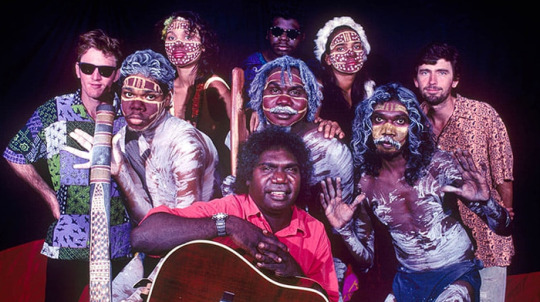
(How Much Do You Know about Yothu Yindi?, 2021)
The origins of Yothu Yindi go back to the 1970s when three brothers, Djawa, Balupalu and Bakamana (later known as Mandawuy Yunupingu), were playing covers of western music at the Yolngu community of Yirrkala, a former missionary settlement.

(Bloggerme, n.d.)
At this time, the group was known as the ‘Diamond Dogs’, referencing David Bowie’s album by the same name and symbolising the Yunupingu brothers’ Gumatj clan (Garrick, 2021, pp. 8). By 1984, the Yunupingu brothers had a new name, ‘Wawa Mala’ (Group of Brothers Band). They were influenced by Graeme Kelly a ‘Balanda’ (non-Aboriginal) from Yirrkala School and who was interested in fusing indigenous and non-indigenous music, eventually a major component of Yothu Yindi’s music. The lead singer, Mandawuy Yunupingu, had a passion for teaching, music and lyric writing:

(ABC News, 2015)
‘…I wanted to become a teacher – in my spare time, I used to write lyrics that meant something to me.’ (ABC, 2022). He went on to be the first Aboriginal principal of a school and was later awarded an honorary doctorate.
By the mid-1980s, Mandawuy was playing with two nephews, Witiyana Marika on vocals, bilma and dance and Milkayngu Mununggurr on didgeridoo. They joined with ‘The Swamp Jockeys’, whose members included Stuart Kellaway on bass guitar, Cal Williams on lead guitar and Andrew Belletty on drums to form ‘Yothu Yindi’, also adding Geoffrey Gurrumul Yunupingu on keyboard, guitar and percussion. ‘Yothu Yindi’ means ‘child and mother’. It is a metaphor for a relationship where both sides care for each other, ‘And that’s basically the principles that govern our lives…’ (Garrick, 2021, pp. 30). This was the first band in Australia’s history with first nation and non-first nation musicians collaborating.
In the 1960s, a bauxite mine was constructed without considering the Yolgnu people’s wishes. This became known as the Gove Land Rights case. The Yolgnu people took Nabalco Corporation to the Northern Territory Supreme Court. They were, however, unsuccessful. This was one of the earliest cases of Indigenous land rights in Australia and was the spark to ignite activism. Mandawuy comes from a family of activists, including his brothers Galararwuy, Gatjil and his father Munggurrawuy Yunupingu.
In 1988, The Barunga Statement of Aboriginal Rights was created by Indigenous leaders and presented to Prime Minister Bob Hawke.
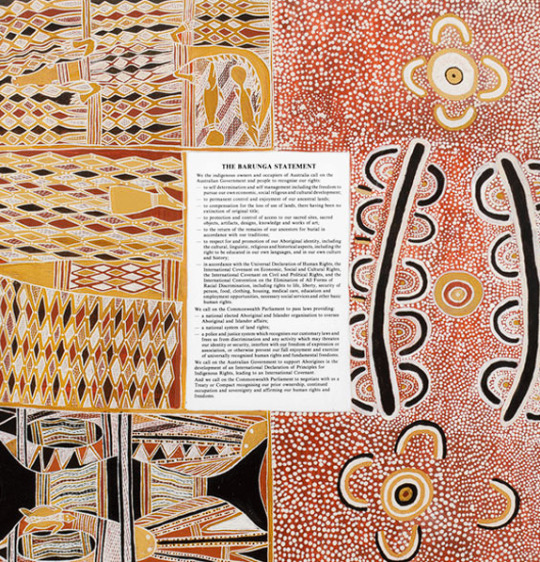
(Studies, 2021)
This was during the Barunga Festival, a celebration of Indigenous culture and sport. Hawke accepted the treaty and wanted to commit to negotiating for the Aboriginal people, but this never came to fruition. With the injustice Mandawuy’s people felt, and politicians failing to deliver their promises, the song ‘Treaty’ was born referencing these events.
youtube
The song was released in 1991 and was the first to include any indigenous Australian language in the lyrics and won song of the year at the APRA awards. The band draws upon ‘Manikay’; a series of songs passed down by generations of ancestors of Yolngu people (ABC Radio National, 2008). The song is a mixture of Yolgnu music and Balanda, the Balanda rock is provided by electric guitars, keyboard and drumkit. The Yolngu rhythms are created by the yidaki (digeridoo) and bilma (clapsticks). The main vocal is provided by Mandawuy though there is also a chorus of mixed Yolngu and Balanda voices (Tim Finn of Split Enz contributed to this). The form of the song conforms to the Balanda rock structure of verses and choruses with an instrumental ‘break’, and the process of intensity through repetition of short motives (Stubington & Dunbar-Hall, 1994), typical of a djatpangarri. The djatpangarri dance and song form is attributed to a famous Gumatj clan member, Dambidjawa (Metzenrath, 2019).
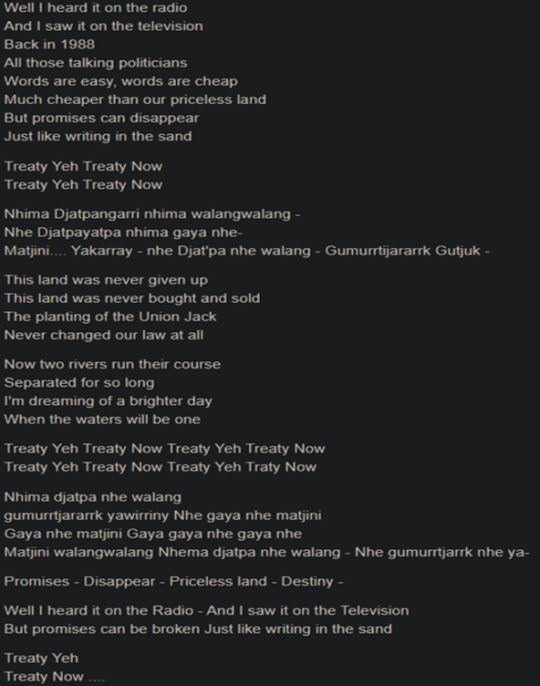
Translations:

The lyrics are in English and Yolngu. The mixing of indigenous and non-indigenous voices is represented in Yolngu ideology by the word ganma, describing the mixing of fresh water from a river with the salt water of the sea.
The song was first released on the Tribal Voice album and then as a single. It was released in the same year on CD as ‘The Filthy Lucre Remix’ which de-politicised the song, removing most of the English verses, though retaining the central message of ‘Treaty yeah, treaty yeah, treaty now’. However, it accentuated the Yolngu nature with lyrics from the language and greater prominence of the didgeridoo and bilma (Kerr, 2015). It was this version which became a rallying cry of the Aboriginal reconciliation movement which led to the Native Title Act of 1993.
youtube
References
ABC. (2022, July 7). Yothu Yindi was a band with a clear vision right from the start. Double J. https://www.abc.net.au/doublej/music-reads/features/yothu-yindi-feature-1997-triple-j-interview-dr-yunupingu/13963328
ABC News. (2015, August 1). Gumatj leader Galarrwuy Yunupingu awarded honorary doctorate at Garma Festival. https://www.abc.net.au/news/2015-08-01/galarrwuy-yunupingu-awarded-honorary-doctorate-at-garma-festival/6665756
ABC Radio National. (2008, July 10). Manikay - Ancestral Songs of Arnhem Land. https://www.abc.net.au/radionational/archived/rhythmdivine/manikay---ancestral-songs-of-arnhem-land/3253540
Bloggerme. (n.d.). |. Retrieved August 14, 2023, from https://www.bloggerme.com.au/states/east-arnhem
Corn, A. (2010). Land, song, constitution: exploring expressions of ancestral agency, intercultural diplomacy and family legacy in the music of Yothu Yindi with Mandawuy Yunupiŋu. Popular Music, 29(1), 81–102. https://doi.org/10.1017/s0261143009990390
Garrick, M. (2021). Writing in the Sand (pp. 8–30). HarperCollinsPublishers Australia Pty Limited .
How much do you know about Yothu Yindi? (2021, October 28). ABC Darwin. https://www.abc.net.au/darwin/programs/drive/writing-in-the-sand/13607656
Kerr, J. (2015, March 2). Treaty by Yothu Yindi – a Trojan horse in the culture wars. The Guardian. https://www.theguardian.com/music/2015/mar/03/treaty-by-yothu-yindi-a-trojan-horse-in-the-culture-wars#:~:text=The%20song%20became%20a%20Trojan
Metzenrath, R. (2019, June 13). Traditional song that inspired Yothu Yindi’s “Treaty” repatriated to Yolgnu Peoples. NITV. https://www.sbs.com.au/nitv/article/traditional-song-that-inspired-yothu-yindis-treaty-repatriated-to-yolgnu-peoples/zde7dftih
Stubington, J., & Dunbar-Hall, P. (1994). Yothu yindi’s “treaty”: Ganma in music. Popular Music, 13, 3. http://www.jstor.org/stable/852915
Studies, A. I. of A. and T. S. I. (2020, October 11). “Treaty” by Yothu Yindi. Aiatsis.gov.au. https://aiatsis.gov.au/blog/treaty-yothu-yindi
Studies, A. I. of A. and T. S. I. (2021, September 15). The Barunga Statement. Aiatsis.gov.au. https://aiatsis.gov.au/explore/barunga-statement
Wikipedia. (2020, December 9). Milirrpum v Nabalco Pty Ltd. https://en.wikipedia.org/wiki/Milirrpum_v_Nabalco_Pty_Ltd#:~:text=Milirrpum%20v%20Nabalco%20Pty%20Ltd%2C%20also%20known%20as%20the%20Gove
Wikipedia. (2023, August 4). Geoffrey Gurrumul Yunupingu. https://en.wikipedia.org/wiki/Geoffrey_Gurrumul_Yunupingu
Yothu Yindi Foundation. (2023). Yothu Yindi. Yothu Yindi. https://www.yothuyindi.com.au/
1 note
·
View note
Text
How Much Money Do Damon Welch Have In 2023?

An American actor for both film and television, Damon James Welch. His work on Raquel's Complete Beauty and Fitness (1984), Biography (1987), and Intimate Portrait are well known (1990). The age of Damon Welch is 59. He was born in San Diego, California, USA, on November 6, 1959. Raquel Welch, an American actress, and singer, is Welch's mother. His father is a writer by the name of James Welch. His eldest sister, Tahnee Welch, is a model and actress.
Hurry up and get the scoop on Damon Welch's net worth! Time's ticking, don't miss out!
Damon Welch's Net Worth
Welch's varied portfolio was successful. Welch had a net worth of almost $40 million at the time of her passing. Welch was more than just a sex icon; perhaps her greatest legacy is that she was one clever cookie.
Check Out:
- Jessica Lowndes Net Worth: Is Collaborate On GAC Family Someday At Christmas?
- Jim Sinegal Net Worth: Why A Costco Brand Almost Had A Whole Different Name?
Damon Welch Family
Raquel Welch, 82, passed away today. Welch "died away quietly early morning following a brief illness," according to her manager Steve Sauer, who confirmed the tragedy people. The actress dies leaving behind two children in addition to a legacy in beauty, cinema, and television. She gave birth to Damon Welch and Latanne "Tahnee" Welch during her marriage to James Welch, her high school sweetheart. Even though James and the actress separated in 1972, she has occasionally been spotted out with her kids throughout the years. Here is all there is to know about Welch's kids.
Damon wed Rebecca Trueman, a cricketer for England and the daughter of Fred Trueman, in June 1991, Welch chose a low-cut black dress for the wedding, and several media outlets reported that Damon and Rebecca were at odds with Welch over the attire decision at the time:
https://twitter.com/BeingBoycie/status/1625982088821325825
Damon Welch: On November 6, 1959, Welch and her then-husband James Welch received their first child, a son they called Damon Welch. Damon appeared with his mother on various occasions over the years. Damon accompanied his mother to the 46th Academy Awards in April 1974, where Welch presented. This was one of Damon's earliest public performances. He went with her to a lot of additional award ceremonies and premieres, such as the Crocodile Dundee 2 Hollywood premiere in 1988 and the 39th Annual Emmy Awards in September 1987 (seen above).
Latanne "Tahnee" Welch: on December 26, 1961. Welch had her first child at the same time that her career was beginning to take off. With breakthrough performances in 1966's Fantastic Voyage and One Million Years B.C., Welch made her film debut in the middle of the 1960s. Welch revealed in a prior interview with Oprah Winfrey how her early profession hurt her family. "I couldn't always be with my children when I wanted to be because I'm running around the world and being Miss Sex Symbol and having this big job in cinema and everything," she added. I eventually realized that this was having an impact on my children, and it used to make me very sad.
FAQs
What Ethnicity Is Raquel Welch?
Welch was born Jo-Raquel Tejada in Chicago, Illinois to a Bolivian father and an American mother.
How Old Is Damon Welch?
63 years (November 6, 1959)
Who Is Raquel Welch Survived By?
She is survived by her son Damon James Welch and daughter Tahnee Welch.
Why Does Raquel Welch Wig?
Raquel Welch famously said in her 2010 autobiography Raquel: Beyond the Cleavage “with the aid of a wig, I have more versatility in my life, and so can you!” And versatility is the key here as one of her wigs can give you as much freedom as if your salon-inspired tresses sprung naturally from your head!
Stay up-to-date on what's happening by checking out The Active News for the freshest news!
Read the full article
0 notes
Text
A New Wave of Masculin Feminin
The French New Wave is one of the most influential movements in cinema’s storied history. A group of French film critics began making low budget movies in direct contrast with the Tradition of Quality of their country’s film industry, and ended up transforming the idea of cinema - in both narrative and formal style, as well as filmmaking production techniques. One of the most important figures in this movement was director Jean-Luc Godard, whose initial credits helped define the characteristics of New Wave films, and whose career continued well past the Nouvelle Wave’s period. Masculin Feminin (1966) is a prime example of both the New Wave’s style and Godard’s personal commitment to infusing politics into the everyday. Focusing on the youth in Paris, it was ironically age restricted when released in French theaters. The film leans into the New Wave’s elements, which can be disjointed and challenging to viewers, and also speaks directly to the social and political climate that was distinctly Parisian in the mid-1960s, captured as a moment in time - as one intertitle in the film comments:
“This film could be called The Children of Marx and Coca-Cola.”
The French New Wave movement began in the late 1950s postwar years with a set of young French film critics working at the Cahiers du Cinema magazine, who pioneered the now ubiquitous auteur theory, proposing that directors are the main authors of a film and express their personal artistic vision in both narrative and formal choices. These critics, including Jean-Luc Godard, François Truffaut, and Jacques Rivette, began making their own films that were in direct contrast to the current state of the French film industry, also known as the Tradition of Quality. The new filmmakers produced low budget films with small crews, working on location with natural lighting and taking advantage of new light-weight cameras for a hand-held aesthetic. Their stories followed non-linear narratives that included disjointed scenes lacking coherent throughlines, chance events or digressive episodes that weren’t necessarily relevant to the main story, and also ambiguous endings. Notably, the protagonists lack traditional characteristics, such as clearly defined goals, and can be difficult for viewers to identify with as leading characters. Finally, the formal elements of the movement include long tracking shots, fragmented style or jump cuts, and a certain cinema verite that mimicked the expanding influence of television, in the form of handheld camerawork and direct reporting interviews. With new stylistic elements, these Nouvelle Wave filmmakers presented a shift in the conception of cinema as one that should simply reflect reality, but instead as an artform that embodies a specific director’s aesthetic.
Jean-Luc Godard was a fiery, yet thoughtful cinema critic turned experimental filmmaker whose body of work contributed to the definition of the French New Wave, and whose subsequent films took on even more political themes. Speaking directly to the youth, he was hyper-aware and engaged with the tides of political and cultural change brewing in the 1960s. He found a way to infuse a real connection between the political and the personal in his films, and also included his pointed critiques of world events. In addition to embodying the auteur theory by making films that express his world vision as art, he also broke with the Hollywood standard of making escapist films; rather, he sought to bring cinema closer to everyday people’s lives. He remained active in filmmaking into the 2010s, cementing his place among the canon of influential filmmakers, especially for his work during the French New Wave.
Masculin Feminin is presented in 15 different chapters, introduced via title cards. In 1960s Paris, Paul (Jean-Pierre Léaud), a young socialist, meets a woman in a cafe named Madeleine Zimmer (Chantal Goya), who aspires to become a singer. Paul begins to pursue her and she begins to record her first album. Some time later, Paul attempts to propose to Madeleine in the same cafe where they met, but is unable to finish the deed. He eventually moves in with Madeleine and her other roommates. Madeleine is revealed to be pregnant and, while on a date in the cinema, she tells Paul that she loves him, but there is additional complicated romantic drama amongst Paul, Madeleine, Paul’s friend Robert and her two roommates. Paul becomes a worker for a French polling company, and he interviews women about politics and love. He eventually purchases a high-rise apartment and falls from the balcony, either by accident or suicide, leaving a pregnant Madeleine behind. She is unsure about her future.
The 1965 trailer for Masculin Feminin ends with the title cards:
“A film in several acts about youth and sex in modern France.”
“Of course, minors under 18 not admitted, because its about them”
Sex - the desire for it from either a partner or from someone you wish would become a partner, the frank discussion of it between friends or random thoughts overheard on the street, the complicated feelings that can arise from withholding or engaging in the act, and the consequences of what sex can bring about in a woman’s body - pervades this film, just as it pervades the thoughts of hormonal young people growing up in a big city. During one of Paul and Madeleine’s first conversations, she asks him if “going out” means “going to bed” - it is clearly his aim, but she is more hesitant. Paul eventually moves in with Madeleine and her roommates and there are heavy suggestions that they are sexually active together. When Paul gets a job as a pollster, he interviews a woman about the subjects of politics and love - and he specifically asks about birth control, a topic which the woman looks authentically uncomfortable speaking about. Birth control methods are discussed throughout the film, including timing sex to specific periods during the cycle, taking the woman’s basal temperature, pulling out, and using a diaphragm (a “gadget from America”). For women of the 1960s, these were the options open to them for protection and none of them are guaranteed, so it is no surprise that Madeleine gets pregnant anyway. Even though this film was representing real life and challenges for young people in 1960s Paris, the open discussion of sex was deemed too controversial by authorities for them to see their life represented on the theater screen.
As the main character, Paul is very challenging to identify with as the protagonist - he makes it difficult as a viewer to root for him, especially as he always seems to be getting in his own way (in a similar fashion to the title character of Llewyn Davis played by Oscar Issac in the Cohen brothers film Inside Llewyn Davis). The ending brings a similar level of angst and ambiguity - Paul’s death occurs off screen and the audience only finds out via dialogue from one of the roommates speaking to the police. To complicate matters further, Madeleine does not know what she will do about the baby. Pregnant, and with her partner dead, her friend suggested using a curtain rod - Goya delivers the line with no expression on her face, which is both devastating and immediately brings to mind the reality that she and millions of women face without easy access to reproductive healthcare choices. These unanswered questions leave the audience not only wondering what Madeleine will do next, but how the generation of Coca-Cola and Marx will navigate the challenges of the 1960s and beyond.
During all of the film’s vignettes, random acts of violence and disruption are frequently interspersed among the scenes, such as a woman arguing with her partner that ends with her shooting him, a racist altercation in a train car that results in another gun firing, and a man who stabs himself on the street. This violence isn’t directly related to the story of Paul and Madeleine, nor does it impact the plot in any way; rather, they are interspersed in between conversations or are observed by the main characters as part of their everyday experience (and often forgotten by the next vignette). These agitated episodes can be interpreted as a commentary by Godard on the rising levels of violence in the urban landscape and modern times.
The politics of the film may also have contributed to the age restrictions in cinemas as well; Godard infused specific commentary on international affairs. Paul and his friend are both socialists, and acts of protest and resistance are peppered throughout the film. They paint “Peace in Vietnam” on the side of a US army vehicle, he graffitis slogans in opposition to a French national politician running for President, and he signs a petition to free incarcerated artists in Rio de Janeiro. Another example of the random violence that pulses through the film - as Paul and Elizabeth (one of the roommates) are walking down the street, a man borrows matches from Paul, only to light himself on fire and kill himself in front of an American hospital, leaving a note that says “Peace in Vietnam.’ While this could have been a very powerful set piece in the film, especially critiquing a controversial war happening on the global stage, unfortunately, the sequence is not executed well in the film, as everything happens off-screen. This may have been a consequence of a low-budget production with effects limitations, but the audience must only imagine the dramatic act of political demonstration.
The formal elements of this film also place it squarely within the French New Wave style. The film’s settings are all shot on location - in a restaurant, in a cinema, in a laundromat - but also prominently features the streets of Paris. The filmmakers captured footage of normal people going about their business in Paris, overlaying those scenes with voiceovers from men and women. This footage also captures the sounds of Paris - the noise of the subway, pinball games at the arcade, washing machines in a laundromat, the city soundscape as people walk the bustling streets at night - but is also interspersed with cuts from Madeleine’s record, random bullet sounds, and the occasional intentional silence.
This staccato energy is also employed via the use of jump cuts - while Paul is telling a story to his friend in a laundromat, his monologue is punctuated by various cuts, channeling his frantic energy in the face of the difficulties of modern life. In contrast to the jump cuts, handheld camera work is highlighted in a long take shot at a restaurant, where Paul is attempting to ask Madeleine to marry him, but can’t quite find the right spot or words. They wander around the restaurant, compelled to movement to escape the various diner’s discussion of sex and relationships, until she becomes frustrated with his awkwardness and rushes out to her appointment with the record company. The use of contrasting techniques within the same film points to the experimental nature of the Nouvelle Wave - and Godard’s use of formal elements to channel the emotional energy of his characters.
Finally, a direct interview scene is also highlighted in the film; when Paul takes on a new job as a pollster, the camera is trained for a long take on one of his subjects. Either this woman is an extremely accomplished actress, or she truly agreed to sit for an interview without knowing what would be asked of her - as her reactions seems genuine and capture the nature of a regular feminine youth in Paris and her thoughts on politics (uncomfortable about discussing socialism), birth control (uncomfortable on the topic, but eventually relents to having some knowledge), and foreign wars (admits she isn’t aware of any details). The choice to never cut puts the entire focus on the subject, with Paul’s questions coming off screen behind the camera. In a film meant to highlight the time’s modern youth of Paris, this sequence is peak time capsule and cinema verite - capturing her candid thoughts on the film’s thematic topics of sex and politics.
Overall, this film captures a moment in time - the formal style and conventions of the French New Wave and the culture of 1960s Parisian youth. All the experimental formal techniques utilized brought a conscious edge to the film that helped define the French New Wave style. The mixing of distinct formal choices with the sex and politics content produced a film whose goal was to challenge traditional norms and both reveal and appeal to the French youth. There are references and moments that speak to a specific cultural milieu and require knowledge of that society’s time and place, but other threads continue to hold relevance despite the years. The formal elements are not afraid to be edgy and raw, just like adolescents, and the film is not afraid to be distracted, messy, and extreme in emotions or sequences. What is Godard’s final message here? Sex is complicated and delightfully fun and can be tragic - and that youth are faced with difficult choices in modern life between love, violence, and the political reality surrounding them. A cut of the 2005 re-release trailer ends with a similar title card to the 1965 version, a fitting evaluation of where the film stands in our current cultural moment:
“Pepsi and the Pepsi Generation are trademark of PepsiCo.
Paris and sex are still in the public domain.”
1 note
·
View note
Photo

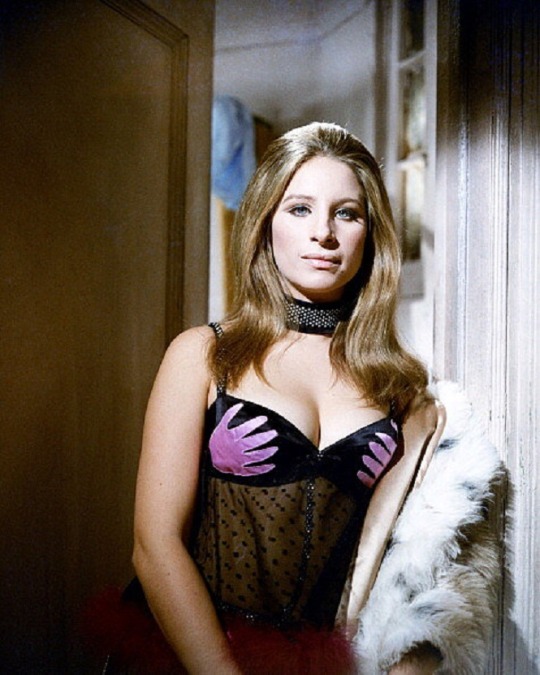


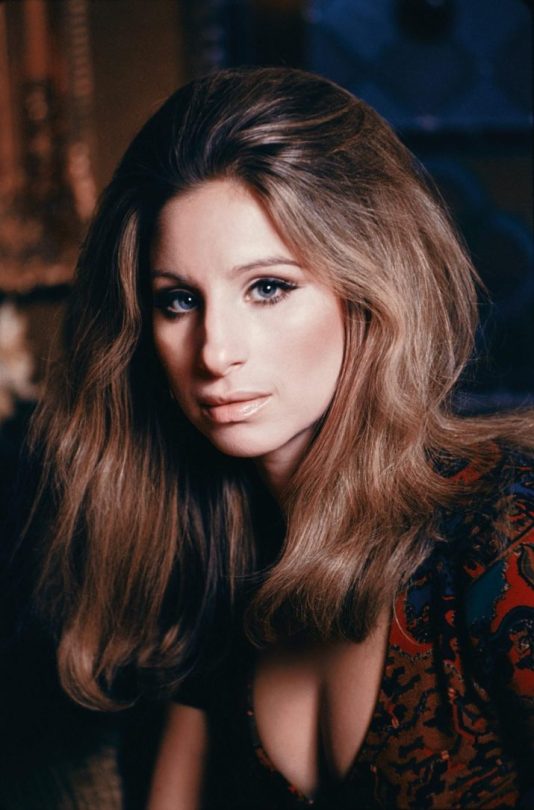


Happy Birthday To Gorgeous American Singer/Actress Barbra Streisand
(Born 24th April 1942)
Pics Sources: Listal.com - Bing Images - Famousfix.com
#barbra streisand#birthday girl#born 24th april 1942#gorgeous american singer/actress#best known for her roles in funny girl (1968) - hello dolly (1969) - on a clear day you can see forever (1970) - a star is born (1976)#also known for what's up doc (1972) - the way we were (1973) - funny lady (1975) - meet the fockers (2004)#years active as a singer 1960-present#only 38 acting credits#years active 1968-2016#pics sources: listal.com - bing images - famousfix.com
103 notes
·
View notes
Text
LGBT writers from India
Ritu Dalmia
Ritu Dalmia (born 1973) is an Indian celebrity chef and restaurateur. She is the chef and co-owner of the popular Italian restaurant Diva in Delhi, which she established in 2000, with co-founder Gita Bhalla under partnership firm "Riga Food".
Gazal Dhaliwal
Gazal Dhaliwal is an Indian screenwriter who recently wrote the screenplay and dialogues for Vinod Chopra Films’ Ek Ladki Ko Dekha Toh Aisa Laga, starring Rajkummar Rao, Anil Kapoor and Sonam K Ahuja. Previously, she has worked on Alankrita Shrivastava's critically acclaimed Lipstick Under My Burkha as the dialogue writer and she wrote the dialogues and co-wrote the screenplay for Qarib Qarib Singlle, directed by Tanuja Chandra, starring Irrfan Khan and Parvathy. She also wrote additional dialogues for Wazir that starred Amitabh Bachchan and Farhan Akhtar.
She is also a public speaker and LGBTQ+ activist, who has spoken openly about being a transgender woman in several talks and in the media – most famously in an episode of the Aamir Khan-led talk show, Satyamev Jayate.
Saagar Gupta
He has written screenplay and dialogues for independent films like The Pink Mirror and Evening Shadows as well as dialogues for several TV episodes of Rishtey, Gubbare, Kagaar and TV shows like Jassi Jaissi Koi Nahin, Left Right Left, Radha Ki Betiyaan among others.
Harish Iyer
Harish Iyer, also known as "Aham", hiyer and "Harrish Iyer" (born 16 April 1979) is an Indian equal rights activist. Iyer engages in advocacy for a number of causes, including promoting the rights of the lesbian, gay, bisexual, and transgender (LGBT) community, children, women, animals, and survivors of child sexual abuse.
Firdaus Kanga
Firdaus Kanga (Born in 1960, age 61) is an Indian writer and actor who lives in London. He has written a novel, Trying to Grow a semi-autobiographical novel set in India and a travel book Heaven on Wheels about his experiences in the United Kingdom where he met Stephen Hawking. Trying to Grow was later turned into a film, Sixth Happiness, for which Kanga wrote the screenplay, and in which he starred.
Ashok Row Kavi
Ashok Row Kavi is an Indian journalist and LGBT rights activist.
Devdutt Pattanaik
Devdutt Pattanaik is an Indian mythologist, speaker, illustrator and author, known for his writing on Hindu sacred lore, legends, folklore, fables and parables. His work focuses largely on the areas of religion, mythology, and management.
Akkai Padmashali
Akkai Padmashali is an Indian transgender activist, motivational speaker, and singer. For her work in activism she has received the Rajyotsava Prashasti, the second highest civilian honor of the state of Karnataka, and an honorary doctorate from the Indian Virtual University for Peace and Education.
Onir
Onir (born Anirban Dhar, 1 May 1969) is an Indian film and TV director, editor, screenwriter and producer. He is best known for his film My Brother…Nikhil, based on the life of Dominic d'Souza, starring Sanjay Suri and Purab Kohli Nikhil was one of the first mainstream Hindi films to deal with AIDS and same-sex relationships.
Onir won the National Award for his film I Am. He has won 16 total film awards.
Suniti Namjoshi
Suniti Namjoshi (born 1941 in Mumbai, India) is a poet and a fabulist. She grew up in India, worked in Canada and at present lives in the southwest of England with English writer Gillian Hanscombe. Her work is playful, inventive and often challenges prejudices such as racism, sexism, and homophobia. She has written many collections of fables and poetry, several novels, and more than a dozen children's books. Her work has been translated into several languages, including Spanish, Italian, Dutch, Chinese, Korean, Hindi and Turkish.
Ismail Merchant
Ismail Merchant (born Ismail Noor Muhammad Abdul Rahman (25 December 1936 – 25 May 2005) was an Indian film producer, director and screenwriter. He worked for many years in collaboration with Merchant Ivory Productions which included Director (and Merchant's longtime professional and domestic partner) James Ivory as well as screenwriter Ruth Prawer Jhabvala.
Hoshang Merchant
Hoshang Dinshaw Merchant (born 1947) is a poet from India. Most of his writings are in English. He is best known for his anthology on gay writing titled Yaarana.
Maxim Mazumdar
Maxim Mazumdar (27 January 1952 – 28 April 1988) was an Indo-Canadian playwright and director. He is known for his one-man show, Oscar Remembered, which tells the story of the Irish playwright Oscar Wilde as seen from the perspective of his lover and nemesis, Lord Alfred Douglas.
Anand Mahadevan
Anand Mahadevan is an Indian-Canadian writer, who was awarded an Honour of Distinction from the Dayne Ogilvie Prize for LGBT writers in 2013.
Born and raised in Tamil Nadu, India, Mahadevan moved to the United States at age 17 to study. He moved to Canada in 2002, and teaches science at the University of Toronto Schools and creative writing at the Humber School for Writers.
The Strike, his debut novel about a young Tamil man's gay sexual awakening, was published in Canada by TSAR Publications in 2006.[4] Its publication in India followed in 2009.
His second novel, tentatively titled American Sufi, is slated for future publication.
He has also been an active supporter of the campaign to strike down Section 377 of the Indian Penal Code, which criminalized homosexuality in India.
He subsequently served on the jury for the 2015 Dayne Ogilvie Prize, selecting Alex Leslie as that year's winner.
Vyjayanti Vasanta Mogli
Vyjayanti Vasanta Mogli is an Indian transgender activist, RTI activist, singer and motivational speaker.She intervened in the “Suresh Kumar Kaushal & Other vs Naz Foundation & Others” Case in the Supreme Court in 2014 in which she highlighted the deleterious effects of conversion or reparative therapy on queer people through her affidavit.
Vijayarajamallika
Vijayarajamallika, known as Daivathinte Makal, is a transgender poet in Malayalam literature, She is a writer, teacher, social worker, inspirational speaker, and activist.
Vasudhendra
Vasudhendra is an Indian author in Kannada language known for his short stories and personal essays.
Ruth Vanita
Ruth Vanita is an Indian academic, activist and author who specialises in British and Indian literary history with a focus on gender and sexuality studies. She also teaches and writes on Hindu philosophy.
Manil Suri
Manil Suri (born July 1959) is an Indian-American mathematician and writer of a trilogy of novels all named for Hindu gods. His first novel, The Death of Vishnu (2001), which was long-listed for the 2001 Booker Prize, short-listed for the 2002 PEN/Faulkner Award and won the Barnes & Noble Discover Prize that year. Since then, he has published two more novels, The Age of Shiva (2008) and The City of Devi (2013), completing the trilogy.
Gopi Shankar Madurai
Gopi Shankar Madurai (Tamil: கோபி ஷங்கர் மதுரை, born 13 April 1991) is an Indian equal rights and Indigenous rights activist. Shankar was one of the youngest, and the first openly intersex and genderqueer statutory authority and one of the candidates to contest in 2016 Tamil Nadu Legislative Assembly election. Shankar is also the founder of Srishti Madurai Student Volunteer Collective. Shankar’s work inspired the Madras High Court (Madurai Bench) to direct the Government of Tamil Nadu to order a ban on forced sex-selective surgeries on intersex infants. In December 2017 Shankar was elected to the Executive board of ILGA Asia. In August 2020 the Ministry of Social Justice and Empowerment appointed Shankar as the South Regional representative in the National Council for Transgender Persons.
Vikram Seth
Vikram Seth CBE, FRSL (born 20 June 1952) is an Indian novelist and poet. He has written several novels and poetry books. He has received several awards such as Padma Shri, Sahitya Academy Award, Pravasi Bharatiya Samman, WH Smith Literary Award and Crossword Book Award. Seth's collections of poetry such as Mappings and Beastly Tales are notable contributions to the Indian English language poetry canon.
Nibedita Sen
Nibedita Sen is a queer Bengali-born writer of speculative fiction. She has been a finalist for the Astounding, Nebula, and Hugo Awards.
Vida Dutton Scudder
She was born in Madurai, India, on December 15, 1861, the only child of David Coit Scudder (of the Scudder family of missionaries in India) and Harriet Louise (Dutton) Scudder. After her father, a Congregationalist missionary, was accidentally drowned in 1862, she and her mother returned to the family home in Boston. Apart from travel in Europe, she attended private secondary schools in Boston, and was graduated from the Boston Girl's Latin School in 1880. Scudder then entered Smith College, where she received her BA degree in 1884.
A. Revathi
A Revathi is a Bangalore-based writer and an activist working for the rights of sexual minorities. She is also a trans woman and belongs to the Hijra community.
R. Raj Rao
Ramachandrapurapu Raj Rao (born 1955) is an Indian writer, poet and teacher of literature who has been described as "one of India's leading gay-rights activists". His 2003 novel The Boyfriend is one of the first gay novels to come from India. Rao was one of the first recipients of the newly established Quebec-India awards.
Sridhar Rangayan
Sridhar Rangayan (also spelt Sridhar Rangaihn or Sridhar Rangayyan; born 2 April 1962) is an Indian filmmaker who has made films with special focus on queer subjects. His queer films, The Pink Mirror and Yours Emotionally, have been considered groundbreaking because of their realistic and sympathetic portrayal of the largely closeted Indian gay community. His film The Pink Mirror remains banned in India by the Indian Censor Board because of its homosexual content.
Rangayan was born in Mandya, Karnataka. As a gay activist, he has been one of the front-rank leaders in the LGBT movement in India and has contributed immensely towards the growth of awareness about sexual minorities in India.
He is a Founder Member and Trustee of The Humsafar Trust, the first gay NGO in India, along with Ashok Row Kavi. He served on its board till January 2013. He also designed and edited India's first gay magazine Bombay Dost between 1999–2003.
Bindumadhav Khire
Bindumadhav Khire is an LGBTQ+ rights activist from Pune, Maharashtra, India. He runs Samapathik Trust, an NGO which works on LGBTQ+ issues in Pune district. He founded Samapathik Trust in 2002 to cater the men having sex with men (MSM) community in Pune city. He has also written on the issues on sexuality in fictional and non-fictional forms including edited anthologies, plays, short-stories, and informative booklets.
Saleem Kidwai
Saleem Kidwai (7 August 1951 – 30 August 2021) was a medieval historian, gay rights activist, and translator. Kidwai was a Professor of History at Ramjas College, University of Delhi until 1993 and thereafter an independent scholar.
#lgbtqiap#lgbtq#lgbtq community#nonbinary#nonbinary lesbian#lesbian#lgbt pride#sapphic#lgbtqia#gay girls#queer#lgbtwriter#lgbtqplus#lgbt books#lgbt nsft#bisexual#lgbtq positivity#queer art#queer culture#queer eye#queerness#queerstake#pride#queer representation#queer romance#queer books#coming out
327 notes
·
View notes
Text
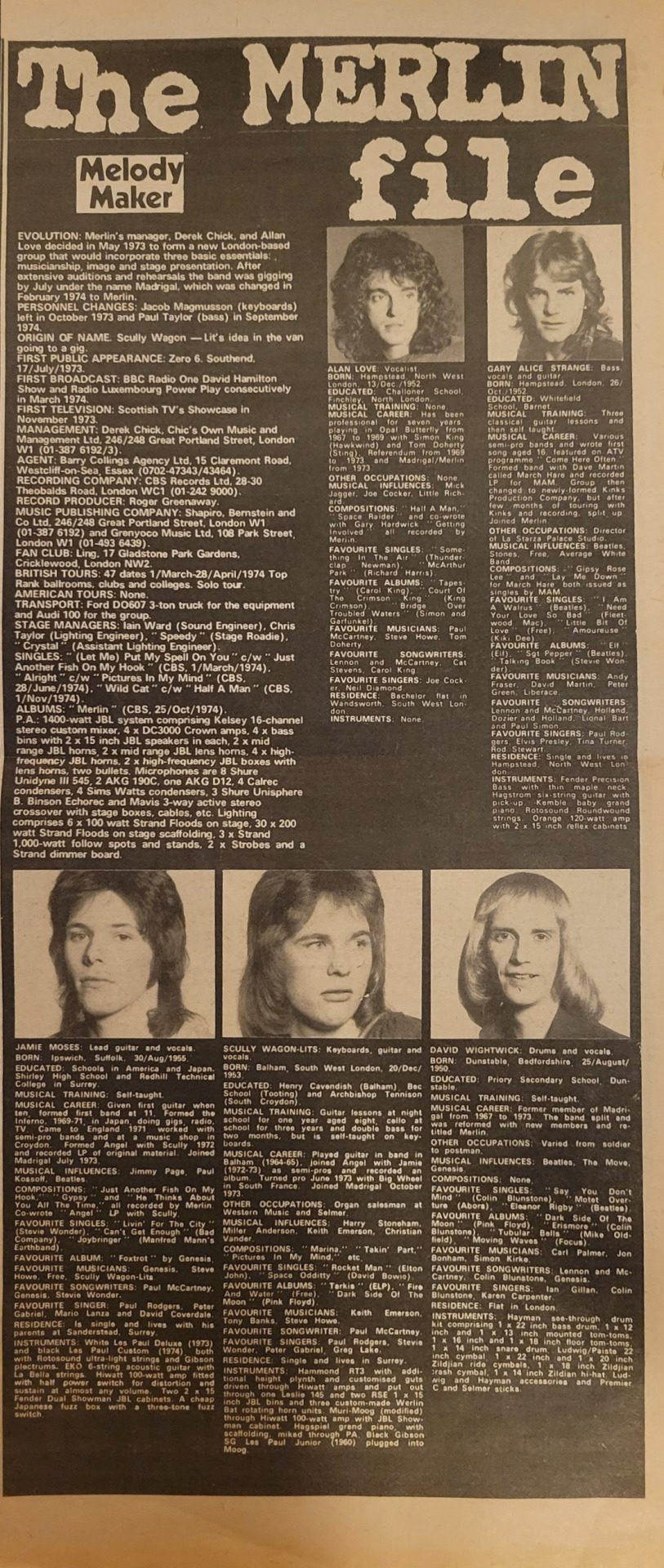
Huge thanks to a very dear friend who bought this article out from underneath me from an ebay auction, and then sent to me as a surprise!
Originally published in Melody Maker in late 1974 (exact date unknown). Full article text below the read more.
The MERLIN File
EVOLUTION: Merlin's manager, Derek Chick, and Allan Love decided in May 1973 to form a new London-based group that would incorporate three basic essentials: musicianship, image and stage presentation. After extensive auditions and rehearsals the band was gigging by July under the name Madrigal, which was changed in February 1974 to Merlin.
PERSONNEL CHANGES: Jacob Magmusson (keyboards) left in October 1973 and Paul Taylor (bass) in September 1974.
ORIGIN OF NAME: Scully Wagon-Lit's idea in the van going to a gig.
FIRST PUBLIC APPEARANCE: Zero 6, Southend, 17/July/1973.
FIRST BROADCAST: BBC Radio One David Hamilton Show and Radio Luxembourg Power Play consecutively in March 1974.
FIRST TELEVISION: Scottish TV's Showcase in November 1973.
MANAGEMENT: Derek Chick, Chic's Own Music and Management Ltd, 246/248 Great Portland Street, London W1 (01-381 6192/3).
AGENT: Barry Collings Agency Ltd, 15 Claremont Road, Westcliff-on-Sea, Essex (0702-47343/43464).
RECORDING COMPANY: CBS Records Ltd, 28-30 Theobalds Road, London WC1 (01-242 9000).
RECORD PRODUCER: Roger Greenaway.
MUSIC PUBLISHING COMPANY: Shapiro, Bernstein and Co Ltd, 246/248 Great Portland Street, London W1 (01-387 6192) and Grenyoco Music Ltd, 108 Park Street, London W1 (01-493 6439).
FAN CLUB: Ling, 17 Gladstone Park Gardens, Cricklewood, London NW2.
BRITISH TOURS: 47 dates 1/March-28/April/1974 Top Rank ballrooms, clubs and colleges. Solo tour.
AMERICAN TOURS: None.
TRANSPORT: Ford DO607 3-ton truck for the equipment and Audi 100 for the group.
STAGE MANAGERS: Iain Ward (Sound Engineer), Chris Taylor (Lighting Engineer), "Speedy" (Stage Roadie), "Crystal" (Assistant Lighting Engineer).
SINGLES: "(Let Me) Put My Spell On You" c/w "Just ANother Fish On My Hook (CBS, 1/March/1974), "Alright" c/w "Pictures In My Mind" (CBS, 28/June/1974), "Wild Cat" c/w "Half A Man" (CBS, 1/Nov/1974).
ALBUMS: "Merlin" (CBS, 25/Oct/1974).
P.A.: 1400-watt JBL system comprising Kelsey 16-channel stereo custom mixer, 4 x DC3000 Crown amps, 4 x bass bins with 2 x 15 inch JBL speakers in each, 2 x mid range JBL horns, 2 x high-frequency JBL boxes with lens horns, two bullets. Microphones are 8 Sure Unidyne III 545, 2 AKG 190C, one AKG D12, 4 Calrec condensers, 4 Sims Watts condensers, 3 Sure Unisphere B. Binson Echorec and Mavis 3-way active stereo crossover with stage boxes, cables, etc. Lighting comprises 6 x 100 watt Strand Floods on stage, 30 x 200 watt Strand Floods on stage scaffolding, 3 x Strand 1,000-watt follow spots and stands, 2 x Strobes and a Strand dimmer board.
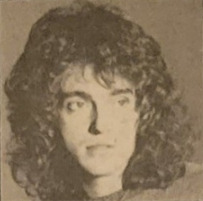
ALAN LOVE: Vocalist
BORN: Hampsted, North West London. 13/Dec./1952.
EDUCATED: Challoner School, Finchley, North London.
MUSICAL TRAINING: None.
MUSICAL CAREER: Has been professional for seven years, playing in Opal Butterfly from 1967 to 1969 with Simon King (Hawkwing) and Tom Doherty (Sting). Referendum from 1969 to 1973 and Madrigal/Merlin from 1973.
OTHER OCCUPATIONS: None.
MUSICAL INFLUENCES: Mick Jagger, Joe Cocker, Little Richard.
COMPOSITIONS: "Half A Man," "Space Raider" and co-wrote with Gary Hardwick "Getting Involved" all recorded by Merlin.
FAVOURITE SINGLES: "Something In The Air" (Thunderclap Newman), "McArthur Park" (Richard Harris).
FAVOURITE ALBUMS: "Tapestry" (Carol King), "Court Of The Crimson King" (King Crimson), "Bridge Over Troubled Waters" (Simon and Garfunkel).
FAVOURITE MUSICIANS: Paul McCartney, Steve Howe, Tom Doherty.
FAVOURITE SONGWRITERS: Lennon and McCartney, Cat Stevens, Carol King.
FAVOURITE SINGERS: Joe Cocker, Neil Diamond.
RESIDENCE: Bachelor flat in Wandsworth, South West London.
INSTRUMENTS: None.

GARY ALICE STRANGE: Bass, vocals and guitar.
BORN: Hampsted, London. 26/Oct./1952.
EDUCATED: Whitefield School, Barnet.
MUSICAL TRAINING: Three classical guitar lessons and then self taught.
MUSICAL CAREER: Various semi-pro bands and wrote first song aged 16 featured on ATV programme "Come Here Often." Former band with Dave Martin called March Hare and recorded LP for MAM. Group then changed to newly-formed Kinks Production Company, but after few months of touring with Kinks and recording, split up. Joined Merlin.
OTHER OCCUPATIONS: Director of La Starza Palace Studio.
MUSICAL INFLUENCES: Beatles, Stones, Free, Average White Band.
COMPOSITIONS: "Gipsy Rose Lee" and "Lay Me Down" for March Hare both issued as singles by MAM.
FAVOURITE SINGLES: "I Am A Walrus" (Beatles), "Need Your Love So Bad" (Fleetwood Mac), "Little Bit Of Love" (Free), "Amoureuse" (Kiki Dee).
FAVOURITE ALBUMS: "Elf" (Elf), "Sgt Pepper" (Beatles), "Talking Book" (Stevie Wonder).
FAVOURITE MUSICIANS: Andy Fraser, David Martin, Peter Green, Liberace.
FAVOURITE SONGWRITERS: Lennon and McCartney, Holland, Dozier and Holland, Lional Bart and Paul Simon.
FAVOURITE SINGERS: Paul Rodgers, Elvis Presley, Tina Turner, Rod Stewart.
RESIDENCE: Single and lives in Hampstead, North West London.
INSTRUMENTS: Fender Precision Bass with thin maple neck. Hagstrom six-string guitar with pick-up. Kemble baby grand piano. Rotosound Roundwound strings. Orange 120-watt amp with 2 x 15 inch reflex cabinets.
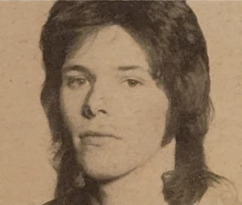
JAMIE MOSES: Lead guitar and vocals.
BORN: Ipswich, Suffolk, 30/Aug/1955.
EDUCATED: Schools in America and Japan. Shirley High School and Redhill Technical College in Surrey.
MUSICAL TRAINING: Self-taught.
MUSICAL CAREER: Given first guitar when ten, formed first band at 11. Formed the Inferno, 1969-71, in Japan, doing gigs, radio, TV. Came to England in 1971, worked with semi-pro bands and at a music shop in Croydon. Formed Angel with Scully 1972 and recorded LP of original material. Joined Madrigal July 1973.
MUSICAL INFLUENCES: Jimmy Page, Paul Kossoff, Beatles.
COMPOSITIONS: "Just Another Fish On My Hook", "Gypsy", and "He Thinks About You All The Time" all recorded by Merlin. Co-wrote "Angel" LP with Scully.
FAVOURITE SINGLES: "Livin' For The City" (Stevie Wonder), "Can't Get Enough" (Bad Company), "Joybringer" (Manfred Mann's Earthband).
FAVOURITE ALBUMS: "Foxtrot" by Genesis.
FAVOURITE MUSICIANS: Genesis, Steve Howe, Free, Scully Wagon-Lits.
FAVOURITE SONGWRITERS: Paul McCartney, Genesis, Stevie Wonder.
FAVOURITE SINGERS: Paul Rodgers, Peter Gabriel, Mario Lanza and David Coverdale.
RESIDENCE: Is single and lives with his parents at Sanderstead, Surrey.
INSTRUMENTS: White Les Paul Deluxe (1973) and black Les Paul Custom (1974), both with Rotosound ultra-light strings and Gibson plectrums. EKO 6-string acoustic guitar with La Bella strings. Hiwatt 100-watt amp fitted with half power switch for distortion and sustain at almost any volume. Two 2 x 15 Fender Dual Showman JBL Cabinets. A cheap Japanese fuzz box with a three-tone fuzz switch.

SCULLY WAGON-LITS: Keyboards, guitar and vocals.
BORN: Balham, South West London, 20/Dec./1953.
EDUCATED: Henry Cavendish (Balham), Bec School (Tooting) and Archbishop Tennison (South Croydon).
MUSICAL TRAINING: Guitar lessons at night school for one year aged eight, cello at school for three years and double bass for two months, but is self-taught on keyboards.
MUSICAL CAREER: Played guitar in band in Balham (1964-65), joined Angel with Jamie (1972-1973) as semi-pros and recorded an album. Turned pro June 1973 with Big Wheel in South France. Joined Madrigal October 1973.
OTHER OCCUPATIONS: Organ salesman at Western Music and Selmer.
MUSICAL INFLUENCES: Harry Stoneham, Miller Anderson, Keith Emerson, Christian Vander.
COMPOSITIONS: "Marina," "Takin' Part," "Pictures In My Mind," etc.
FAVOURITE SINGLES: "Rock Man" (Elton John), "Space Oddity" (David Bowie).
FAVOURITE ALBUMS: "Tarkis" (ELP), "Fire And Water" (Free), "Dark Side Of The Moon (Pink Floyd).
FAVOURITE MUSICIANS: Keith Emerson, Tony Banks, Steve Howe.
FAVOURITE SONGWRITERS: Paul McCartney.
FAVOURITE SINGERS: Paul Rodgers, Stevie Wonder, Peter Gabriel, Greg Lake
RESIDENCE: Single and lives in Surrey.
INSTRUMENTS: Hamond RT3 with additional height plynth and customised guts driven through Hiwatt amps and put out through one Leslie 145 and two RSE 1 x 15 inch JBL bins and three custom-made Werlin Bat rotating horn units. Muri-Moog (modified) through Hiwatt 100-watt amp with JBL Showman Cabinet. Hagspiel grand piano, with scaffolding, miked through PA. Black Gibson SB Les Paul Junior (1960) plugged into Moog.

DAVID WIGHTWICK: Drums and vocals.
BORN: Dunstable, Bedfordshire, 25/August/1950.
EDUCATED: Priory Secondary School, Dunstable.
MUSICAL TRAINING: Self-taught.
MUSICAL CAREER: Former member of Madrigal from 1967 to 1973. The band split and was reformed with new members and retitled Merlin.
OTHER OCCUPATIONS: Varied from soldier to postman.
MUSICAL INFLUENCES: Beatles, The Move, Genesis.
COMPOSITIONS: None.
FAVOURITE SINGLES: "Say You Don't Mind" (Colin Blunstone), "Motet Overture" (Abors), "Eleanor Rigby" (Beatles)
FAVOURITE ALBUMS: "Dark Side Of The Moon (Pink Floyd), "Erismore" (Colin Blunstone), "Tubular Bells" (Mike Oldfield), "Moving Waves" (Focus).
FAVOURITE MUSICIANS: Carl Palmer, Jon Bonham, Simon Kirke.
FAVOURITE SONGWRITERS: Lennon and McCartney, Colin Blunstone, Genesis.
FAVOURITE SINGERS: Ian Billan, Colin Blunstone, Karen Carpenter.
RESIDENCE: Flat in London.
INSTRUMENTS: Hayman see-through drumkit comprising 1 x 22 inch bass drum, 1 x 12 inch and 1 x 13 inch mounted tom-toms, 1 x 16 inch and 1 x 18 inch floor tom toms, 1 x 14 inch snare drum, Ludwig/Paiste 22 inch cymbal, 1 x 22 inch and 1 x 20 inch Zildjian ride cymbals, 1 x 18 inch Zildjian crash cymbal, 1 x 14 inch Zildjian hi-hat, Ludwig and Hayman accessories and Premier C and Selmer sticks.
#merlin band#jamie moses#(I continue to not tag the rest because everyone continues to not care)#long post //#text#jamie
29 notes
·
View notes
Text
Musical Offerings for the New Year || What is “Radical Music” in 2021?

Near the end of 2020, a bunch of musicians populating a chatroom, including myself, each submitted ten minutes’ worth of our work to another musician, Chimeratio, who generously compiled it all into a set totaling nearly ten hours.¹ The work didn’t need to be new; just what we thought might best represent our abilities/style(s) and/or perhaps what we were especially pleased with. The set premiered in late January. Since I have some tentative plans for reorienting Brick By Brick this year, while not overriding its emphases, I wanted to share that music with anyone who’s interested.
I compiled the four videos into a playlist, although you can also access them individually: here (1), here (2), here (3), and here (4). If you care to, and are on a computer, you can also view the accompanying chatlog and read people’s responses from when they were listening to the live broadcast.
The compulsion for this project was sparked by excited discussions over and usage of the term “digital fusion”, most helpfully propagated by Aivi Tran, designating a computer-based body of work that for years lacked the rooftop of a commonly agreed upon genre-name. While describing my music has never been a big concern, even if it’s usually felt impossible (what, for example, is this? or this? I dunno!), I’ve appreciated how the spread and application of this term has brought together people who may have felt isolated.²
As “digital fusion” gained designative traction, I witnessed the activity in the aforementioned chatroom explode over the course of a few days. Before, a day’s discussion might’ve been a few dozen messages; now, there were dozens of messages every half-minute. This had positive and negative ramifications, the negative being that conversations often proceeded at a pace of rapidity which precluded concentrated thought. Eventually, I bowed out because the rapidity exceeded my threshold for meaningful interaction; but I was glad that significant invigoration was going on.
I wanted to share this music also because it intersects with thoughts and talks I’ve been having stemming from the question, “What is ‘radical music’ in 2021?” This was stimulated by a 2014 talk given by the writer Mark Fisher, wherein he contends that, were we to play prominent “cutting edge” music from now to people twenty years ago, very nearly none of it would be aesthetically shocking, bizarre, or revelatory (think of playing house music to an audience in the early 1960s!). Fisher also observes a trend of returning to music which once was seen as the future -- as if, deprived of a shared prograde vision, imaginations turn hazily retrograde; ergo, genres such as synthwave or albums like Daft Punk’s Random Access Memories.
It isn’t my goal here to argue about the “end of history.” Fisher’s time-travel hypothetical, however, rings loud and true to me. Visible musical radicalism has, for at least a decade, been strictly extra-musical, in the sense of songs like “This is America” or “WAP”, where one’s response is primarily to the spectacle of the music video, the performer’s identistic markers, and/or the manner in which the lyrics intersect with (mostly US-centric) ideological hotspots. Musically, there is really nothing radical here. Any vociferous condemnations or defenses of a song like “WAP” deal in moralizing reactions to semantics or imagery: how progressive or regressive is the political aspect? how propelled or repelled are we by the word “pussy”?
It would be a mistake, and simply wrong, to assert that the only music one can enjoy escapes the parameters outlined above; and my inability to coherently categorize some of my own music hardly raises that portion to the status of radicality. But the question here pertains to what is being made, and I think that if we’re going to seriously consider the nature of truly radical music today, we do need to question if such a quality can prominently exist when our hyper-fast consumerist cycle seems to forbid not just sustained, lifelong relationships to artwork but also the local, unhurried nourishment of creative gestation. Now, in my opinion, there are good, even great, examples of radical music still being made in deep Internet-burrows, and for evidence of that I would offer some of the material contained in the linked playlists. Moreover, I’d say that this quality can exist in part because these little artistic communities are so buried.
Let me share a quote that another person shared with me recently:
For culture to shift, you need pockets of isolated humanity. Since all pockets of humanity (outside of the perpetually isolated indigenous people in remote wilderness) are connected in instantaneous fashion, independent ideas aren’t allowed to ferment on their own. When you cook a meal, you have to bring ingredients together that have had time to grow, ferment, or decompose separately. A cucumber starts out as a seed, then you mix it with the soil, water and sunlight. You can’t bring the seed, soil, water and sunlight to the kitchen from the get-go. When you throw those things in to the mixture without letting them mature, the flavor cannot stand out on its own. Same thing with art and fashion. A kid in Russia can come up with a new way to dance, gets filmed on a phone, it goes viral quickly but gets lost in the morass of all of the other multitudinous forms of dance. Sure it spread far and wide, but it gets forgotten in a week. In the past, his new art form would have been confined locally, nurtured, honed, then spread geographically, creating a distinct new cultural idiosyncrasy with a strong support base. By the time it was big enough to be presented globally, it was already a cultural phenomenon locally. This isn’t possible anymore. We’re consuming too many unripened fruits.
The main impression I have here is that radical music today will, and must be, folk music. Our common idea of folkiness might be the scrappy singer strumming a guitar, but my interpretive reference rather has to do with the idea of a music being written, first of all, for one’s self, and then shared with a small-scale community, which in turn helps the artist grow at their own pace. This transcends a dependence upon image, the primacy of acoustic instrumentation, or the signaling of sincerity versus insincerity. It is a return to the valuation of outsider art, so rare nowadays. As someone who I was recently in dialogue with wrote, “Where can you find new genuine folk music? Pretty much just with your friends, imo. Even then, the global world is so influential and seeps into any crack it can find. I think vaporwave was radical and folk for a while. Grant Forbes made that music way before the world knew about it.”
Sometimes, a lot of fuss is made over what’s seen as “gatekeeping” within certain communities. It can be, depending on the context, justifiable to question and critique this behavior. At other times, the effort of maintaining a level of exclusivity, of retaining an idiosyncratic shapeliness to the communal organism, can be a legitimate attempt to protect the personal, interpersonal, and cultural aspects from the flattening effect of monoculture. Hypothetically, I welcome the Castlevania TV series and Super Smash Bros. Ultimate having introduced new and younger demographics to Castlevania. In actuality, stuff like “wholesome sad gay himbo Alucard”, image macros, and neurotic “stan” fanfiction being what’s now first associated with the series makes me want to put as much distance as possible between my interests and those latecoming impositions.
The group-terminology David Chapman uses in his essay “Geeks, MOPs, and Sociopaths in Subculture Evolution” is kinda cringey, but some of the cultural/behavioral patterns he lays out are relevant to the topic. Give it a look. If we cross his belief that “[subcultures] are no longer the primary drivers of cultural development” with our contemporary consume-and-dispose customs, we’re left with the predicament of it’s even worth attempting to bring radical/outsider art beyond its rhizomatic habitat. This is troubling, because it would mean that artistic radicality no longer might not only refuse to but cannot encompass cultural upheaval. It would be like if dance music were invented and -- instead of progressively permeating nightlife, stimulating countercultural trends, and ultimately being adapted as the basis for pop music globally -- only were listened to via headphones by a few thousand people on their own, stimulated a group meeting once a year or two, and never affected music beyond a niche-within-a-niche. That’s a very sad picture to me.
⁂
¹ Chimeratio has also maintained an excellent blog on here dedicated to looking at videogame music written in irregular time signatures, far preceding higher-profile examinations like 8-bit Music Theory’s video on the same topic.
² For myself, creative isolation has had its uses, because it has led me down routes that are highly personalized. The isolation can be dispiriting too. Although a lot of my music is videogame-music-adjacent, almost none of it uses “authentic” technology, such as PSG synthesizers or FM synthesis; and the identification of those sounds is fairly important for recognition.
30 notes
·
View notes
Photo
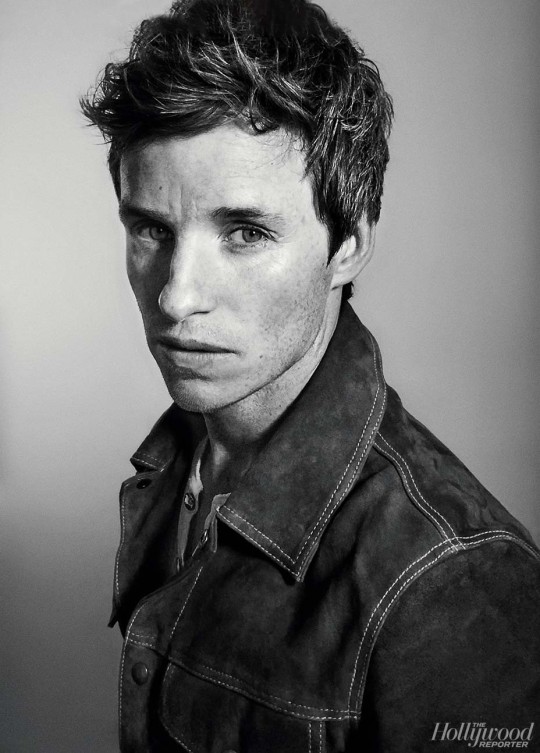
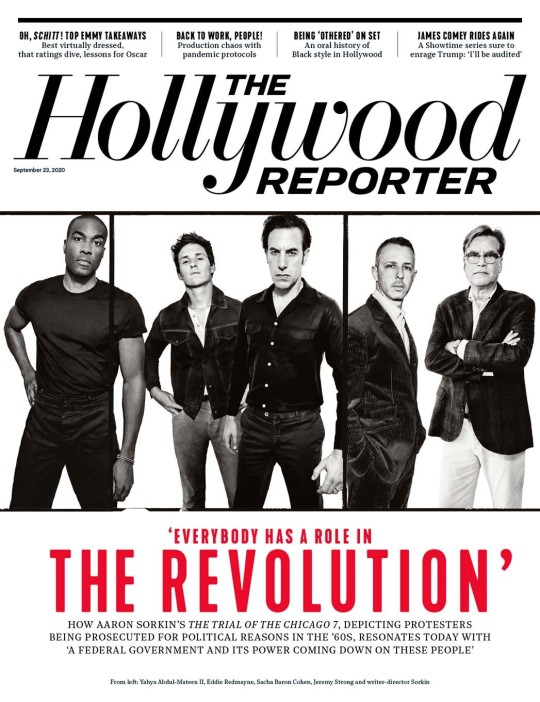
photos by Frank Ockenfels
The Long Journey and Intense Urgency of Aaron Sorkin's 'The Trial of the Chicago 7'
by Rebecca Keegan September 23, 2020, 6:00 am PDT
The director of the Netflix film, which stars Sacha Baron Cohen, Jeremy Strong, Eddie Redmayne and Yahya Abdul-Mateen II, reveals why it took nearly 20 years to get the project about the politically motivated prosecution of protestors made and why it couldn't be more timely: "I never imagined today would go so much like 1968."
In October 2019, hundreds of protesters marched down Chicago’s Michigan Avenue toward the Hilton, chanting phrases like "No justice, no peace!" and "A people united will never be defeated!" as police in riot gear descended on the crowd with billy clubs and tear gas. Earnest and energized, clad in 1960s period costumes and flanked by vintage police vehicles, this group thought they were acting out the past, staging a scene from Aaron Sorkin’s The Trial of the Chicago 7. As it turned out, they were performing the future, too.
Sorkin’s film, which opens in select theaters Sept. 25 and hits Netflix on Oct. 16, tells the story of the riots at the 1968 Chicago Democratic National Convention and the circus-like trial of political activists that followed the next year. Thanks to Hollywood development hell, the movie is arriving 14 years after Steven Spielberg first mentioned the idea to Sorkin but just as its themes and plot points — civil unrest, a self-proclaimed "law and order" president’s vilification of protesters (Nixon then, Trump now), the police’s excessive use of force, tensions within the Democratic Party over how far left to move — have become bracingly current."I never wanted the film to be about 1968," Sorkin says in an interview over Zoom from his house in the Hollywood Hills on Labor Day weekend. "I never wanted it to be an exercise in nostalgia or a history lesson. I wanted it to be about today. But I never imagined that today would get so much like 1968."For only the second time in a career spanning nine films as a screenwriter, Sorkin serves as director with Chicago 7, helming a sprawling ensemble cast that includes Eddie Redmayne as anti-war activist Tom Hayden, Sacha Baron Cohen as Youth International Party (Yippie) provocateur Abbie Hoffman, Succession’s Jeremy Strong as counterculture figure Jerry Rubin and Watchmen’s Yahya Abdul-Mateen II as Black Panther party co-founder Bobby Seale. There are undeniable parallels not only between the film and the present political moment but also between the performance-art activism of the actors and the men they’re playing, most vividly Cohen, who, like Hoffman, has made a career of political self-expression through comedic stunts, including crashing a far-right rally in Olympia, Washington, this summer while pretending to be a racist country singer. (Cohen, who shoots most of his satirical projects incognito, impishly calls reports of his appearance at the rally "fake news.")Eight months after Sorkin filmed the protest scenes in Chicago, Abdul-Mateen was marching in Black Lives Matter protests in West Hollywood, as was Strong in Brooklyn. "There’s power when a lot of people come together to protest out of anger, out of frustration," Abdul-Mateen says. "Everybody has a role in the revolution; this film shows that.
"Though the movie feels crafted for this political moment, it was born of another. At Sorkin’s first meeting with Spielberg, "I remember him saying, 'It would be great if we could have this out before the election,'" Sorkin says. The election Spielberg was talking about was 2008’s, when Barack Obama and Joe Biden faced John McCain and Sarah Palin.The film hit multiple roadblocks, beginning with the 2007-08 writers strike and continuing as financing faltered repeatedly, a fate illustrated by the more than 30 producers who can claim some sort of credit on Chicago 7. It took another unscheduled detour this summer after Sorkin finished it as the pandemic worsened, and the odds of original distributor Paramount mounting a successful theatrical release before the Nov. 3 election seemed increasingly slim. For some involved with the film, there is a question about the ethics of Hollywood inviting audiences to return to theaters before a COVID-19 vaccine is widely available. "
There’s a moral quandary that we, the motion picture business, have to be careful that we don’t become the tobacco industry, where we’re encouraging people to do something we know is potentially lethal," says Cohen.Before his visit to Spielberg’s Pacific Palisades home to discuss the project on a Saturday afternoon in 2006, Sorkin knew next to nothing about the Chicago 7. The federal government had charged seven defendants — Hoffman, Rubin, Hayden, David Dellinger, Rennie Davis, John Froines and Lee Weiner — with conspiracy for their participation in the protests against the Vietnam War outside the Democratic National Convention. (Originally the men were known as the Chicago 8 and included Seale, who asked to have his trial separated from that of the others and postponed so that he could be represented by his preferred lawyer, who was ill; that trial never took place.)
When Spielberg proposed a movie about the riots and the trial that followed, Sorkin, who was 7 in 1968, said, "'You know, that sounds great. Count me in.' As soon as I left his house, I called my father and said, 'Dad, do you know anything about a riot that happened in 1968 or a crazy conspiracy trial that followed?' I was just saying yes to Steven."Despite his ignorance, Sorkin was a logical choice to write the project: Having penned Broadway’s A Few Good Men and its 1992 film adaptation as well as the long-running NBC series West Wing, he’d shown a flair for dramatizing courtroom procedures and liberal politics, and he turned in his first draft of the Chicago 7 script in 2007. Originally, Spielberg planned to direct the project himself, but by the time the writers strike was over, he had moved on and a number of other potential directors circled, including Paul Greengrass, Ben Stiller, Peter Berg and Gary Ross, though none was able to get it off the ground. "There was just a feeling that, 'Look, this isn’t an Avengers film,'" Sorkin says of the studios' move away from midbudget dramas and toward action tentpoles in the 2010s. "This isn’t an easy sell at the box office. And there are big scenes, riots, crowd scenes. How can this movie be done for the budget that makes sense for what the expectation is at the box office?"As the project languished, Sorkin tried writing it as a play, ultimately spending 18 months on a fruitless effort to fashion a stage treatment. "What I didn’t like was having a script in my drawer," he says. "I was just thinking, 'Jeez, this is a good movie and it feels like it’s stillborn.'"It was the confluence of two events that ultimately revived the film with Sorkin in the director’s chair in 2018 — the 2016 election of Donald Trump and the 2017 release of Sorkin’s well-received directorial debut, Molly’s Game, which doubled its production budget at the box office. "This is before George Floyd and Breonna Taylor and police protests or confrontations," Sorkin says. "This is just when Donald Trump was musing nostalgically about the old days when they used to carry that guy [a protester] out of here on a stretcher and punch the crap out of him."With Trump’s throwback rhetoric lending the subject matter a new timeliness and Sorkin’s directing chops confirmed in Spielberg’s eyes, the movie moved forward with its screenwriter at the helm.
Cross Creek Pictures came in to finance, and Paramount bought the domestic rights. But all those years in development had left an expensive imprint on the project — a jaw-dropping $11 million had been spent on casting costs, producing fees and the optioning of Brett Morgen’s 2007 documentary about the event, Chicago 10, leaving just $24 million for the actual 36-day production.
One way Sorkin attempts to achieve a sense of scope despite that budget is by intercutting real black-and-white news footage with his dramatized protests. He rounded out his large cast with a deep bench of experienced and award-winning actors including Oscar winner Mark Rylance as defense attorney William Kunstler, Oscar nominee Frank Langella as Judge Julius Hoffman, Joseph Gordon-Levitt as prosecutor Richard Schultzand, Oscar nominee Michael Keaton as former U.S. Attorney General Ramsey Clark — with the filmmaker and many of his actors working for scale. (Abdul-Mateen and Strong both became first-time Emmy winners Sept. 20.)Sorkin shot the protest scenes on location in Chicago and built a courtroom set in an old church sanctuary in Paterson, New Jersey, because none of the available courtroom locations in the Garden State conveyed the scope he wanted. "If we’re saying the whole world is watching, I want a packed courtroom for six months full of press and spectators," Sorkin says. "I wanted the big, cavernous feeling of the federal government and its power coming down on these people."
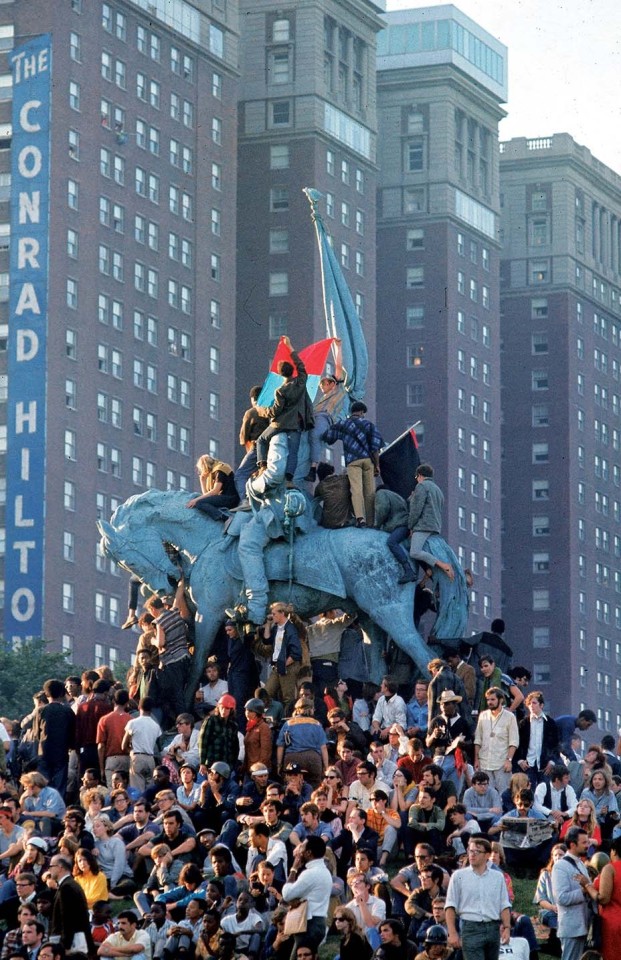
Julian Wasser/The LIFE Images Collection via Getty Images/Getty Images "The movie is tribute to the bravery of the protesters of 1968 [pictured] and today in Belarus, on the streets of America, in Portland," says Cohen.
Among the vestiges of Spielberg’s original plan was the casting of Cohen as Hoffman, which required the London native to affect a Boston accent and return to a subject he had studied as an undergraduate at Christ’s College in Cambridge, where he wrote a thesis paper about Jewish activists during the civil rights movement. At 19, Cohen had interviewed Bob Moses, the leader of the Student Nonviolent Coordinating Committee, which Hoffman was involved in before he founded the anti-war Yippie movement. "Honestly, I was very proud of the fact that Jews were involved in the Black civil rights movement in the '60s, and there wasn’t much written about it," Cohen says, explaining his youthful scholarship.
There’s a clear line to draw between Hoffman’s 1960s theatrics — which included throwing fistfuls of money into the gallery of the New York Stock Exchange and vowing to levitate the Pentagon — and Cohen’s contemporary TV and film pranks. Perhaps among Cohen’s most memorable and pointed gags was getting Vice President Dick Cheney to gleefully autograph a waterboard kit, which the comic did while posing as an admiring Israeli anti-terror expert for a 2018 episode of Who Is America?, his Showtime series. “What I wanted to do was to show that he was proud of torturing," Cohen says. "I could not believe how happy Cheney was to be sitting next to an uber-fan. So, yes. Ultimately in the shows and the movies that I do, I’m trying to be funny, but yeah, I’m trying to get out the anger that I have within me."
Cohen sees Hoffman’s unorthodox protest methods as pragmatic. "The Yippies were underfunded, and he was using theatricality to gain attention for his aims," Cohen says. "He wanted to stop the war. And how do you do that? You use stunts and absurdist humor to try to effect change." The actor estimates that, after researching Hoffman, he pitched Sorkin hundreds of lines the activist had really delivered. "As an annoying person with a lot of chutzpah, I was emailing Aaron every other night until morning, 'What about this line? What about this line?'" Cohen says. The writer-director, known for his exacting prose, politely tolerated the suggestions while largely sticking to his own script.
As Rubin, Strong is playing Hoffman’s conscientious jester sidekick, a role wildly different from the tragic, wealthy approval seeker he portrays on Succession. Strong added some of his own dramatic flourishes, including painting words on his chest for one courtroom scene and bringing a remote-controlled fart machine to disrupt Langella’s imperious judge. "I wanted to channel as much as possible that spirit of the merry prankster and of joyous dissent," Strong says. Hoffman and Rubin’s real-life personae were so large that Sorkin at times asked his actors to dial down their faithful portrayals, requesting, after one particularly jubilant take, "less cowbell."
Sorkin’s script draws a sharp contrast between Hoffman and Rubin’s campy methods and Hayden’s more reserved approach to the anti-war movement, with the tensions between Hoffman and Hayden supplying the film’s key relationship in a kind of begrudging brotherhood of the peace movement. To learn more about Hayden, Redmayne studied remarks that Jane Fonda, who was married to the activist and politician from 1973 to 1990, made upon his death in 2016. In his own life, Redmayne is cautious when it comes to discussing the role that he, as an actor at the center of a huge studio franchise (Warner Bros.’ Fantastic Beasts) might have in political life. "I find it endlessly challenging," Redmayne says of navigating his public activism. "There’s the elitist thing. It’s speaking up on climate change but being conscious that you’re traveling a lot. One has to be aware of one’s own hypocrisies, because they can be detrimental to something you believe in. So sometimes I find that I have to live my life and speak to my advocacy in a way in that it’s around friends, family and people I know rather than making something public."
Abdul-Mateen has begun his acting career largely associated with fantastical roles, like Dr. Manhattan on HBO’s Watchmen, Black Manta in Aquaman and Candyman in the upcoming Jordan Peele-produced remake of the slasher film. Playing Seale represented a chance to do more grounded work and to depict a man who had loomed large during Abdul-Mateen’s childhood in Oakland, where Seale co-founded the Black Panthers in 1966 and later ran for mayor. Seale’s inclusion in the original Chicago riots indictment was controversial and strange — prosecutors accused him of conspiring with men he’d never met after visiting Chicago that week for only a few hours to deliver a speech. For the prosecution, Seale functioned largely as a prop to tap into the fears of white jurors and white Americans watching the news coverage, and during the trial he had no attorney. "I wanted to key in on, how did Bobby Seale survive this trial?" Abdul-Mateen says. "How did he survive the gross mistreatment by the United States government, and how did he go through that with his head high and not be broken? It was an exercise in finding my pride, finding my dignity."
In one scene, Seale is brought into the courtroom bound and gagged, and throughout the trial he is kept separate from the white defendants. "Although it was meant to be a humiliating act, I walked out with my chest high, with my head high. Bound and gagged and everything else. It would be very dangerous for a Black man in that time, even sometimes today, to show the proof of the wear and tear that oppression can take on a person, because that can be seen as a sign of weakness, and a sign of weakness is an open door that it’s working." For the moments of lightness that Cohen and Strong bring to the movie, Abdul-Mateen supplies ballast. "It’s important for the right reasons and at the right time to make art that makes people uncomfortable," he says.

Niko Tavernise/NETFLIX. On the set, from left, Yahya Abdul-Mateen II, Mark Rylance, Ben Shenkman, Aaron Sorkin and Eddie Redmayne
Spielberg has remained involved in the film "in an emeritus role," Sorkin says, "from giving me good script notes to casting to notes on early cuts of the film." He also showed up to the New Jersey courtroom set. "When you have to direct a scene in front of Steven Spielberg, you’re not at your most relaxed necessarily," Sorkin says. Spielberg did not, however, take an executive producing credit on the film and declined to be interviewed about it.
The decision to switch to a streaming release came after an early summer marketing strategy call between Sorkin, Paramount chief Jim Gianopulos, other Paramount execs and some of the film’s producers. "At the end of the call, Jim said, 'Listen, we don’t know what the theater business is going to look like in the fall. We have troubling data telling us that the first people back in movie theaters are going to be the people who think that the coronavirus is a hoax,'" Sorkin says. This was clearly not the intended audience for a movie whose heroes are liberal activists. "I said, 'I don’t think the Idaho militia are going to be the first people coming to this movie,'" Sorkin says.
The group agreed to explore alternatives and gave Netflix, Amazon, Apple and Hulu 24 hours to watch the film. After a bidding war, Chicago 7 landed at Netflix in a $56 million deal against its $35 million production budget, with a robust marketing campaign and promise of a theatrical release. "We knew we didn’t have the option of 'Let’s wait a year,'" Sorkin says. "This is what we’re thinking about and what we’re talking about right now, and it just would have been a real shame to not release it now."
After Chicago 7 opens in limited release, Netflix will add more theaters in the U.S. and abroad throughout October, expanding upon the film’s premiere on the service, a strategy akin to what it provided Oscar best picture nominees The Irishman and Roma, albeit in a wildly different theatrical environment.
As Hollywood opens up to more production, Sorkin, and many of the Chicago 7 actors, have begun returning to work. Abdul-Mateen has been in Berlin for The Matrix 4 and Redmayne in London for Fantastic Beasts 3, while Sorkin is shooting a West Wing reunion special at the Orpheum Theatre in downtown L.A. that will premiere on HBO Max in October as a fundraiser for When We All Vote and include video appearances by Michelle Obama, Bill Clinton and Lin-Manuel Miranda
For the real-life Chicago 7, the denouement consisted of ultimately being acquitted of conspiracy. Judge Hoffman sentenced Seale to four years in prison for contempt of court, one of the longest sentences ever handed down for that offense in the U.S., but those charges were overturned on appeal. Just three of the original eight defendants — Seale, Froines and Weiner — are still alive, but the legacy of the case lives on in contemporary protest movements. "The movie is tribute to the bravery of the protesters of 1968 and the protesters of today in Belarus, on the streets of America, in Portland," Cohen says. "These people now are risking their lives, and they’ll continue risking them."
https://www.hollywoodreporter.com/features/the-trial-of-the-chicago-7-aaron-sorkin-and-stars-on-films-timeliness-to-election-and-why-everybody-has-a-role-in-the-revolution
#eddie redmayne#Aaron Sorkin#director#screenwriter#netflix#movie#the trial of the chicago 7#yahya abdul mateen ii#Sacha Baron Cohen#mark rylance#joseph gordon levitt#jeremy strong#Michael Keaton#The Hollywood Reporter#tom hayden#civil rights#frank ockenfels#photos#oscar winner#best actor#best cast#frank langella#newton scamander#newt scamander#fantastic beasts#the danish girl#the theory of everything
41 notes
·
View notes
Text
BARBARA EDEN
August 23, 1931

Barbara Eden was born Barbara Jean Morehead in Phoenix Arizona in 1931, although for years her birth year was thought to be 1934. It was fairly common for young actresses to lie about their age in Hollywood. After her parents divorced, her mother married a telephone lineman, the same profession as Lucille Ball’s father. Eden's first public performance was singing in the church choir. As a teenager, she sang in local bands in night clubs. At age 16, she studied singing and acting. She graduated from High School in San Francisco in the Spring Class of 1949. As Barbara Huffman, she was elected Miss San Francisco in 1951 and she also entered the Miss California pageant. Her name was changed to Eden by her first agent.
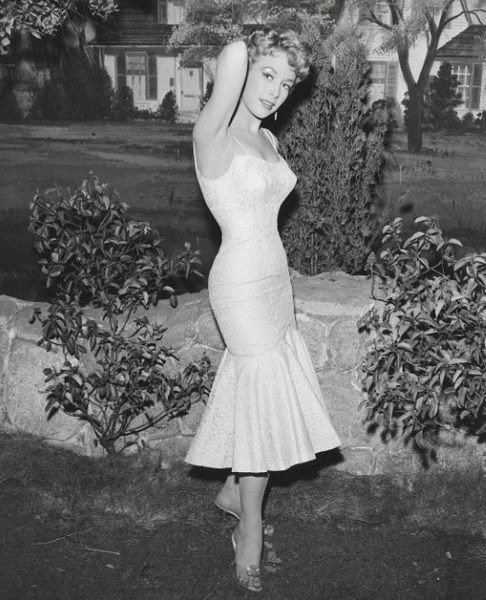
“If gentlemen prefer blondes then I'm a blonde that prefers gentlemen.” ~ Barbara Eden

Eden began her television career as a semi-regular on “The Johnny Carson Show” (not to be confused with “The Tonight Show”) in 1955.
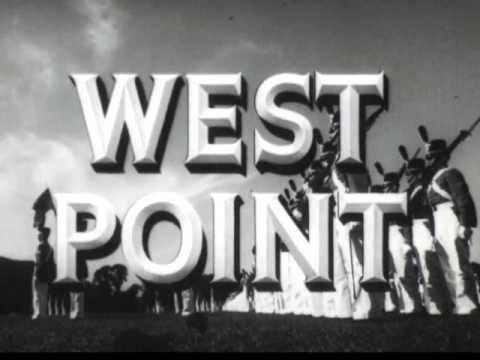
Contrary to popular belief, "I Love Lucy” was not Eden’s first small screen appearance. She had been seen in a November 1956 episode of “West Point.”
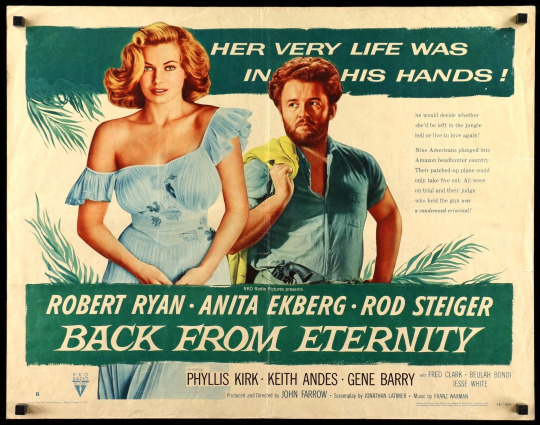
She had also made the RKO film Back from Eternity, a remake of a Lucille Ball film called Five Came Back, which would not be released until later in 1957. It was directed by John Farrow (Mia’s father) and co-starred Keith Andes, who would play Lucy Carmichael’s boyfriend on “The Lucy Show” and co-star with Ball in Wildcat on Broadway in 1960. Eden played a college reporter and was uncredited. Coincidentally, the film also featured Tristram Coffin, who played Diana Jordan’s cousin Harry Munson in “Country Club Dance.”

In “Country Club Dance” (ILL S6;E25), the male population of Westport is all agog when sexy Diana Jordan (Barbara Eden) visits. Lucy, Ethel and Betty Ramsey decide that getting glamorous is the best revenge. The now-classic episode was filmed on March 21, 1957 and first aired on April 22, 1957.
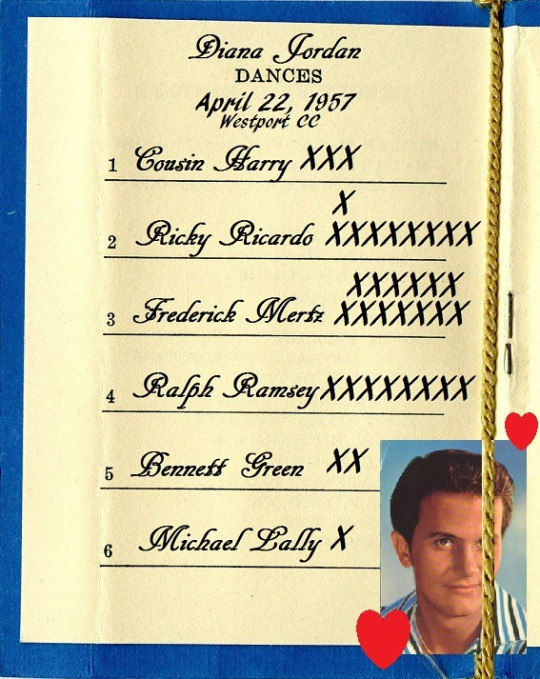
Needless to say, that night at the Westport Country Club shapely young Diana’s ‘dance card’ is full! Pat Boone (not in attendance, but mentioned) was Diana’s favorite singer!

William Asher, the director of this episode, would later direct Barbara Eden in the short-lived sitcom "Harper Valley PTA” (1981-82) and "I Dream of Jeannie… Fifteen Years Later,” a reunion special aired in 1985.

After filming was completed, Desilu gave some of its guest stars small gifts. This 10K gold-filled Zippo lighter was a present for Eden.

That same year, Eden appeared in an episode of the Desilu sitcom “December Bride” starring Harry Morgan.
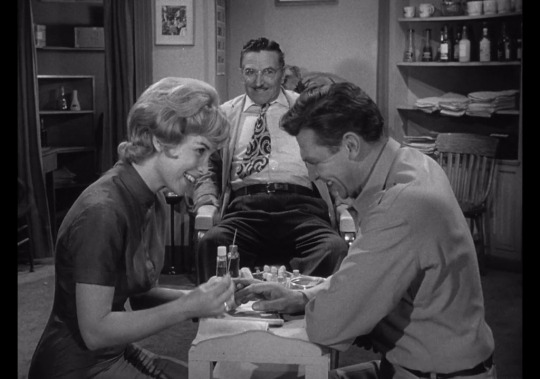
In early 1962, Eden was on the Desilu backlot to play “The Manicurist” on “The Andy Griffith Show.” At the same time, “The Lucy Show” was filming its first season.
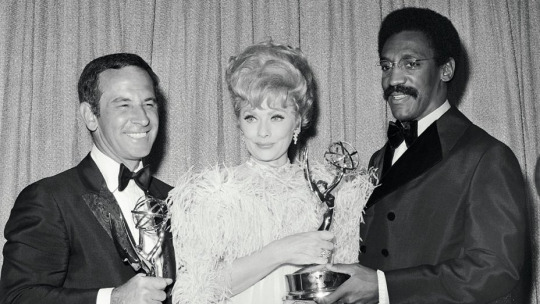
The next time Lucy and Eden appeared on screen together was at the 1968 Primetime Emmy Awards. Ball was nominated (and won) for Best Actress in a Comedy for “The Lucy Show”. “Jeannie” and Eden were then in their third season, but failed to break the top 30 and were not nominated, although Eden, as a recognizable TV figure, was present at the awards. Throughout its long run, the popular sitcom only garnered one Emmy nomination, for Sidney Sheldon’s writing. Barbara and Ball were also presenters (not together) at the 1986 Prime Time Emmy Awards.

In 1982, Lucy and Eden were among the many women (and one man in drag) assembled for “Bob Hope’s Women I Love: Beautiful and Funny.” Coincidentally, this special also featured Mary Martin, who was Larry Hagman’s (Major Nelson on “I Dream of Jeannie”) real-life mother. Eden was a favorite of Hope’s, appearing on a dozen Bob Hope specials.
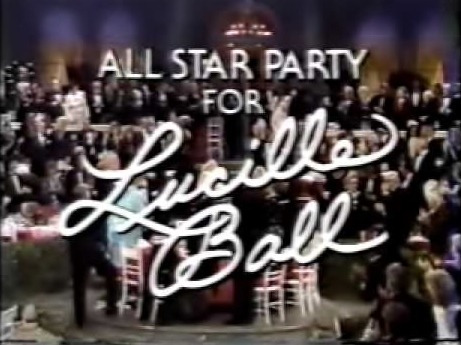
Eden was present (though she did not speak or get credited) at 1984′s “All-Star Party for Lucille Ball.” Two years later they returned for “All-Star Party for Clint Eastwood.” As a former honoree, Lucy hosted, but Eden was still only an attendee.
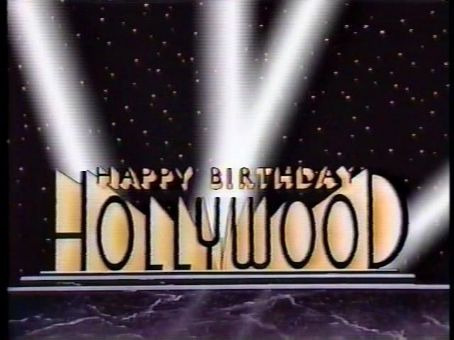
In 1987, Lucy and Barbara joined a myriad of luminaries for “Happy 100th Birthday Hollywood” although they performed in different segments. A year later, Lucy, in one of her final TV appearances, was with Eden in “The Princess Grace Foundation’s Special Gala Tribute to Cary Grant.” Grant never acted opposite either star.
OUT OF THE BOTTLE!

In 1965, producer Sidney Sheldon signed Eden to star in his upcoming fantasy sitcom “I Dream of Jeannie” that would air on NBC. It was aimed at wooing audiences away from ABC’s fantasy sitcom “Bewitched.” Eden played Jeannie, a beautiful genie from ancient Persia set free from her bottle by astronaut and Air Force Captain (later Major) Anthony "Tony" Nelson, played by Larry Hagman.

Also in the “Jeannie” cast of regulars was Hayden Rorke (as psychiatrist Dr. Alfred Bellows), who first appeared with Lucille Ball on stage in Dream Girl (1947).

Like Eden, Rorke also did a one-off appearance on “I Love Lucy” as new neighbor Mr. O’Brien who Lucy thinks is a spy, but turns out to be just an actor.
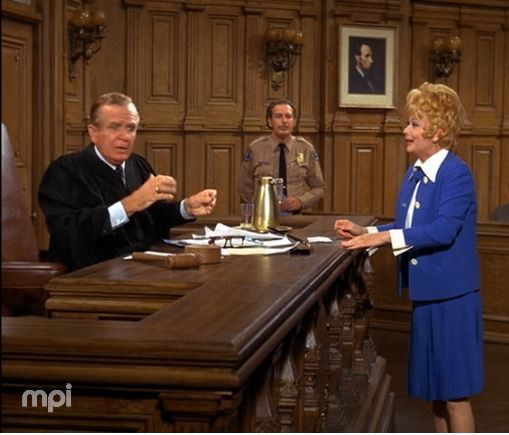
He would later be seen on “Here’s Lucy” as a judge deciding if Lucy Carter has held an illegal raffle or not.
Lurene Tuttle, who played the President of The Wednesday Afternoon Fine Arts League in “The Club Election” (ILL S2;E19) in 1953, played Jeannie’s mother in a 1965 episode.
Phil Ober, Vivian Vance’s ex-husband and the actor who played Dore Schary in “Don Juan is Shelved” (ILL S4;E21) in 1955, played General Stone in two season one episodes of “Jeannie.”
Vinton Hayworth, who played General Schaeffer on “Jeannie” did two films with Lucille Ball: That Girl From Paris (1936) and That’s Right - You’re Wrong (1939).

Like Vance, Eden also was married to one of her co-stars and later divorced him. In 1958, Eden married Michael Ansara, who played many roles on “Jeannie” including the Blue Djinn (above).
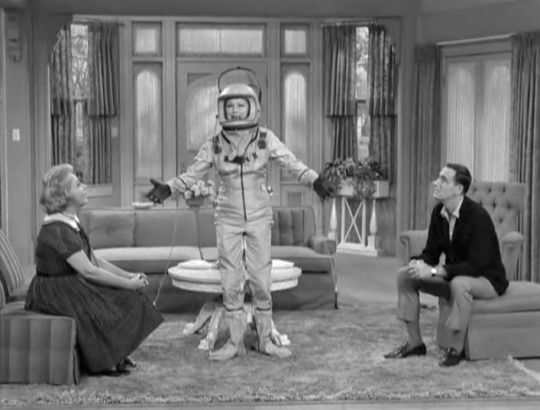
On “Jeannie,” Major Nelson was an astronaut. On “The Lucy Show” Lucy Carmichael was an astronaut (for a day) in a season one episode. Like “Jeannie” this episode was written to capitalize on America’s space race.
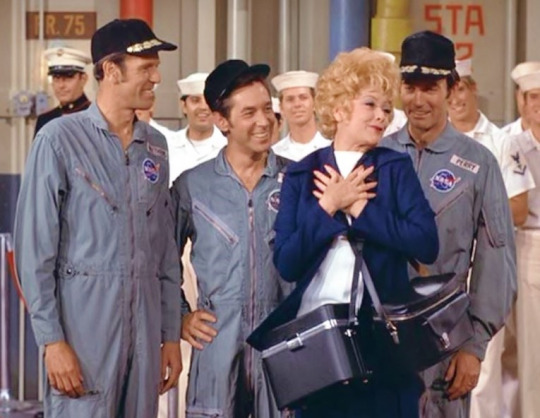

In 1971, “Here’s Lucy” also did an astronaut-themed episode. By that time, American astronauts had landed on the moon! Coincidentally, actor Robert Hogan (center in both photos) also played an astronaut on “Jeannie” in 1970.
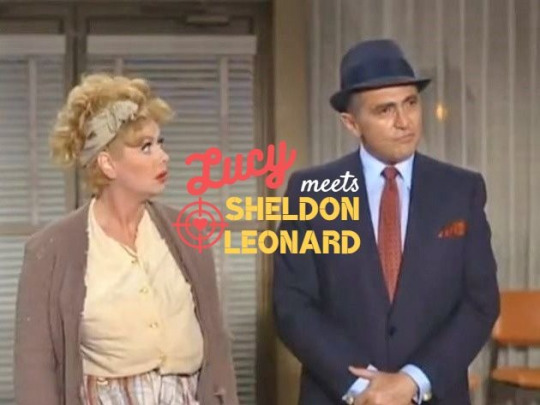
“Jeannie” was produced by Sheldon Leonard, who played himself on a 1967 episode of “The Lucy Show”.
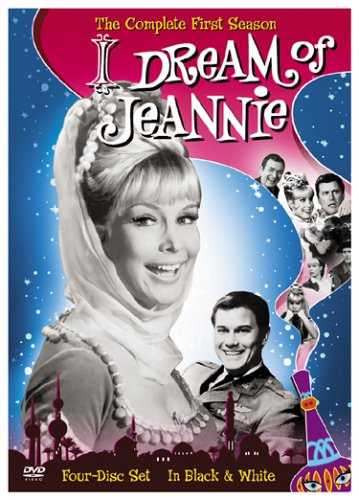
Like “The Lucy Show”, “Jeannie” premiered in black and white before switching to color for the remainder of its run.
Other actors who appeared on both “Jeannie” and “Lucy”: George DeNormand, Benny Rubin, Jackie Coogan, J. Pat O’Malley, Reta Shaw, Richard Reeves, Romo Vincent, Jonathan Hole, Kathleen Freeman, Bill Quinn, Herbie Faye, Milton Berle, Jack Carter, Jamie Farr, John McGiver, Richard Deacon, Don Ho, Alan Hewitt, Don Rickles, Alan Oppenheimer, Jack Collins, Parley Baer, Herb Vigran, Ruth McDevitt, Sandra Gould, Foster Brooks, James Hong, William Fawcett, Stafford Repp, and Sid Melton.

Eden played this role for five years and 139 episodes. In eight episodes, Eden donned a brunette wig to portray Jeannie's evil sister (also named Jeannie) who lusts after Tony Nelson, and in two episodes played Jeannie's hapless mother.
AFTER THE BALL & THE BOTTLE....

Barbara Eden later said in interviews that Lucy was a generous performer and caring person, contrasting to another (unnamed) female star she had worked with. Lucille Ball thought that Eden’s costume was not attractive enough, so Lucy and Irma Kusely (Lucy’s hairstylist) spent rehearsal time ‘bedazzling’ the dress. Ball offered to put Eden under contract at her Desilu Workshop, but Eden found out later that day that 20th Century Fox had picked up her option, so Eden graciously declined Lucy’s offer.
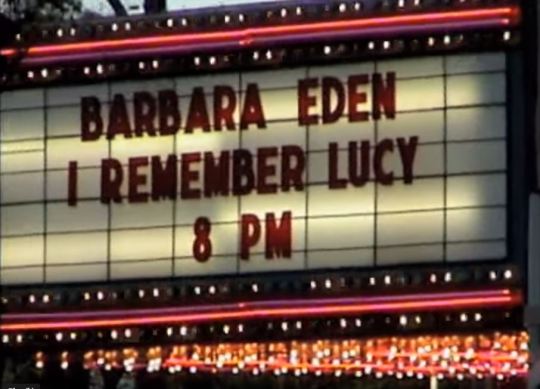
"It was the third job I had in Los Angeles and she was so good to me. I can’t tell you how sweet she was. I had a dress on that she didn’t think was outstanding enough. She asked me to take it off and the next thing I knew, she was sitting there putting sparkling things all over it, just to make it look better.” ~ Barbara Eden, October 2017
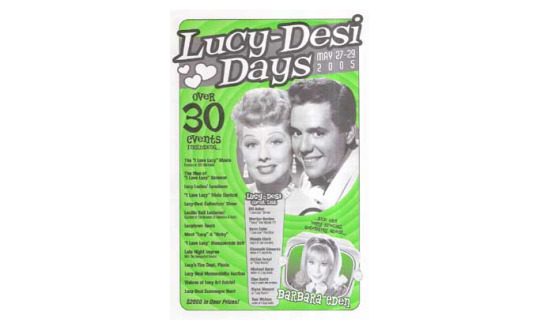
In 2005, Barbara Eden traveled to Jamestown to participate in Lucy-Desi Days.

Eden was married three times and had one child who died in 2001 at the age of 35.
“I've never stopped working. If you're active, you can appreciate what you did in the past, you don't feel like it's gone.” ~ Barbara Eden
AS OF TODAY!
AUGUST 23, 2020 - As of this writing, Barbara Eden is one of the oldest known surviving ADULT cast members of “I Love Lucy.” She is not, however, the oldest. Mary Ellen Kaye (Mrs. Taylor in “Lucy Hates To Leave”) is a year older than Eden, and Cher’s mother Georgia Holt (Model in “Lucy Gets A Paris Gown”) is 94.
There is no birth or death information for: Maggie Magennis (Starlet in “Don Juan and the Starlets”), Helen Silvers (Dancer Rosemary in “Lucy is Jealous of Girl Singer"), Barbara Logan (Stewardess in “The Ricardos Visit Cuba"), Milldred Law (Stewardess in “Return Home from Europe”), and Jody Drew (Miss Ballantine, Mr. Reilly’s Secretary in "Don Juan is Shelved").
#Lucille Ball#Barbara Eden#I Love Lucy#I Dream of Jeannie#Desi Arnaz#Hayden Rorke#Vivian Vance#Astronauts#NASA#Jeannie#Lucy#TV#sitcoms#Sheldon Leonard#The Lucy Show#Here's Lucy#Larry Hagman#Michael Ansara#Phil Ober#Robert Hogan#Dream Girl#Bob Hope#Country Club Dance#Back From Eternity#Johnny Carson#West Point#The Andy Griffith Show#December Bride#Lurene Tuttle#Vinton Hayworth
39 notes
·
View notes
Text
Armenian Women in Visual Arts

I took a class on Armenian culture and history in university that exposed me to this beautiful country and people and opened my eyes to the undeniable tragedy of the Armenian Genocide of 1915.
I’m not Armenian, but I’m Greek on my dad’s side which I found out is very similar. We both love our dolma’s and hate the Turks. But in all seriousness, we share a lot of similarities with Armenian culture, including its political history, which has helped me to further empathize with the current struggles they are facing as a country. It's heartbreaking to see that, just five years after the 100 year anniversary of the Armenian Genocide, Armenians appear to be facing a second genocide. Armenia’s neighboring country Azerbaijan has been ensuing deadly attacks against them for some time now with the aid of Turkey and the issue continues to be mostly ignored by the international community. Protests have been raging on both in the nation and diaspora. In no way do I consider myself to be an expert on this subject, but I feel responsible at least to educate myself and do my part as a citizen of the world.

There is no civilization in the world that, given it possess the resources and will, doesn’t have artists, doctors, lawyers, chefs, musicians, poets, farmers, accountants, etc... The meaning of this to me is that it is proof we are all valuable people, no matter where we come from or what we look like. Just think about how sand is made from millions of tiny parts but looks like one uniform blanket on the beach. If you were to put a handful of sand into a jar, and another handful into another jar, you’d find that each jar is made up of entirely different rocks. But somehow, both have all the elements needed to still look like a handful of sand. That’s how I view culture. Every culture is a handful of sand; they all have necessarily found their own way to explain the universe (religion), their own way to communicate (language), their own way to nourish themselves (diet), and so on... and each way is original and different. But somehow, all of the elements add up to create a civilization, a culture, and a people with a shared identity. The only thing that makes us different is that we’re arbitrarily placed into one jar and not another, but when you look at the big picture, we’re all the same.

As embarrassing as it is to admit, I think by human nature it’s much easier to care about someone else’s journey in life when they have something in common with you. What I love about art is that when you meet another artist, no matter who, you feel a sort of magical connection to that person and are bonded over your mutual appreciation of it. I am a woman and I am an artist, and because of that, I feel lucky and unworthy in saying I have something in common with these incredibly talented Armenian women that I’m about to share with you.
I. Zabelle Boyajian (1872-1957)
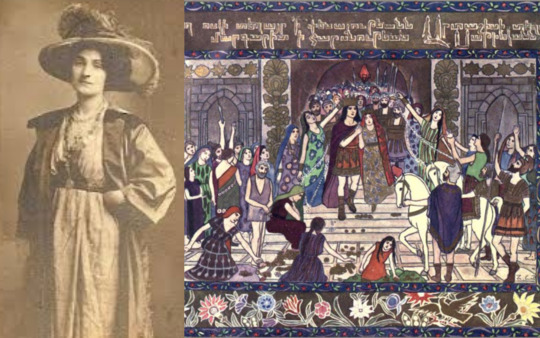
Zabelle C. Boyajian was a poet, painter and playwright of the Ottoman Empire, born in 1872 in Diyarbakir, one of the ancient Armenian capitals, ‘Tigranakert’. After the murder of her father during the Hamidian Massacres of 1895, she, her mother and her brother immigrated to London. She travelled extensively throughout her lifetime and learned to speak eight languages fluently, including Armenian, English, German, Italian, Greek, Turkish and Russian. Being skilled in so many languages, apart from the arts, she was a great contributor to the translation of many great Armenian works. For example, in 1948, she translated Avetik Isahakian’s epic poem “Abu Lala Mahari” and published it for the world to read. In 1938, thanks to her wide travels, she published several illustrations from her visit to Greece, entitled “In Greece with Pen and Palette”. Exhibitions of her art were held in London, Egypt, France, Italy, Belgium and Germany. She was close friends with Anna Raffi, the wife of the well-known Armenian novelist, Raffi. One of the leading female trailblazers of art, literature and translation, she published her first novel in 1901, entitled “Esther”. She is well known today for her gorgeous storybook illustrations.
II. Miriam Aslamazian (1907-2006)

Miriam Aslamazian, sometimes called the Armenian Frida Kahlo, was born on October 20th, 1907 in Alexandropol in the village of Bash-shirak. She was was a Soviet painter of Armenian descent recognized for her exquisite ceramic plates. In 1929, she graduated from the Yerevan Art-Industrial Technicum and later in 1933, from the Leningrad Academy of Art. In 1946, she became a member of the CPSU (the Communist Party of the Soviet Union). Her work is often described as decorative, flat still-life pieces as well as possessing dramatic, colorful themes. Many pieces of her artwork can be found today in the Aslamazian Sisters’ Museum in Gyumri. She was honored as People’s Artist of the Armenian SSR 1965 and People’s Artist of the Soviet Union in 1990.
III. Gayane Khachaturian (1942-2009)

Gayane Khachaturian, born May 9th, 1942 in Tbilisi, Georgia, was a Georgian-Armenian graphic artist and painter. She studied at the Nikoladze Art School and the Secondary School of Working Youth, where she graduated in 1960. Sergei Parajanov, who she was close friends with, was a major inspiration for her. Some of her works are permanently displayed and can be seen at the National Gallery of Armenia, the Yerevan Museum of Modern Art as well as the Sergei Parajanov Museum in Yerevan. Her works have also been purchased and are included in several private art collections. Her first informal solo exhibition was at Skvoznyachok Café in Yerevan in 1967.
IV. Sonia Balassanian

Sonia Balassanian is a mixed media artist, art curator, founder and Artistic Director of the Armenian Center for Contemporary Experimental Art in Yerevan, Armenia. Born in Iran of Armenian descent on April 8th of 1942, Balassanian uses her artwork to advocate for human rights and women's emancipation issues. In 1970, she obtained a BFA from the Pennsylvania Academy of Fine Arts and the following year worked on an independent study program at the Whitney Museum of American Art. In 1978, she completed her MFA from Pratt Institute in Brooklyn, New York. The following year, however, the 1979 events in Iran caused her to turn to “political art” as self expression. She is also a skilled writer, publishing several works, including, “There Might Have Been An Insane Heart” (1982), composed of selected poems written in the Armenian language, “Portraits” published in New York in 1983 and “Two Books” (2006), a publication of two books of poems in one combined.
V. Nora Chavashian

Nora Chavashian is an award-winning production designer, art director and set decorator, recognized for her sculptural stage sets, born in Philadelphia, PA on October 25th, 1953. OMG we have the same birthday, no wonder I like her! There, she studied sculpture at the Pennsylvania Academy of Fine Arts. In 1974, Chayashian graduated from the San Francisco Art Institute (SFAI). In 1984, she married Joe Morton, an American actor, director, writer, singer and songwriter, with whom she has three children, Hopi, Seta and Ara, and one grandson, Moses. In 1988, she and her family relocated to the East Coast. Her sculptures often have organic shapes and are reminiscent of nature.
VI. Anush Yeghiazaryan

Anush Yeghiazaryan is a painter, weaver and professor born on June 15th, 1965 in Yerevan, Armenia, known for her stunning tapestry creations. Hailing from the family of Karapet Yeghizaryan, patriarch of the Armenian school of art weaving, she has held up the traditional weaving techniques of her ancestors. From 1984 to 1990, she studied graphic design at the Yerevan State Fine Arts Academy. From 1991 to 1994, she worked on obtaining her PhD from the State Armenian Pedagogical University. In 1996, she became a member of the Armenian Union of Artists. In 2010, Yeghiazaryan joined the Pan-Armenian Painting Association. She has had her work presented in exhibitions around the world, from Yerevan to Paris, Moscow, Sankt Petersburg, Bouve, Plovdil, Tehran, Italy and Praha. Quoted for saying, “I have not chosen art, it’s in my blood. It’s my lifestyle and I love it up to sublimation degree”. Some of her pieces displaying masterful weaving techniques include,“If you live, create” (1998), “Once Upon a Time in Paris” (2003), and “Urbanization” (2006).
VII. Taleen Berberian

Taleen Berberian is a modern Armenian visual artist, specializing in mixed mediums, crafted fabric, clay sculptures, drawing and the use of the traditional Armenian sewing, embroidery and crochet techniques in unconventional ways. She is especially recognized for her famous sculptures of shoes. Berberian has been on the forefront of women’s issues, a theme that can be seen through her artwork. She is an active participant in both Los Angeles and New York’s art communities. In 1995, she obtained a BFA in Sculpture from the California College of the Arts in Oakland, California and in 1998 she continued on to achieve a MFA in Studio Art and Art Education from Pratt Institute in Brooklyn, New York. In 2009, she received her Initial Teachers’ Certification in Visual Art for grades K-12 and currently serves as a quilting and ceramics instructor.
VIII. Joanne Julian

Found out artist Joanne Julian and I are both CSUN alum and native Angelenos! Julian, who is of Armenian ancestry, says she has been highly influenced by her travels to Asia and thus became skilled in certain Asian techniques, such as mono printing and the “flung ink” or “Haboku” style. Her pieces possess a “Zen quality” to them, as portrayed in her “Zen Circle” series, illuminating the Yin and Yang of Taoist painting. She received her Bachelor’s of Arts and her Masters in sculpture and printmaking from California State University, Northridge. She later received her MFA from the Otis Art Institute of Parsons School of Design. She has participated in over sixty group exhibitions and twenty solo exhibitions nation-wide. Since 1973, Julian has served as the Chair of the Fine Arts Department and Gallery Director at the College of Canyons in Valencia, California. In 2008, from January 25th to February 23rd, she held an exhibition at CSUN’s Art Gallery entitled, “Counterpoints”.

All of the female artists I mentioned have given people a better look into what it means to be Armenian and how the community and its diaspora are trying to solidify the Armenian identity to enable its rich heritage and traditions to live on. And they are just a few of the proud Armenians who have helped raise awareness of the issues Armenians face, as well as give Armenians their due respect in the realm of International Art. And to go one step further, my deepest hope is that one day, art will overcome the war.
#armenian#armeniangenocide#genocide#journalism#armenianprotests#azerbaijan#femaleartists#artists#art#artist#femaleartist#armenianart#armenianartist#armenianartists#armenia#culture#zabelleboyajian#joannejulian#taleenberberian#anushy#Miriamaslamazian#Sonia Balassanian#soniabalassanian#female artists#armenian genocide#armenian artists#armenian art#armenianwomen#armenian women#peaceforarmenians
14 notes
·
View notes